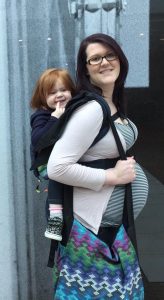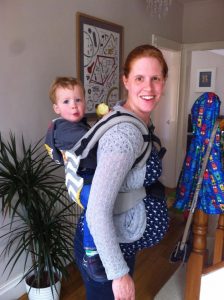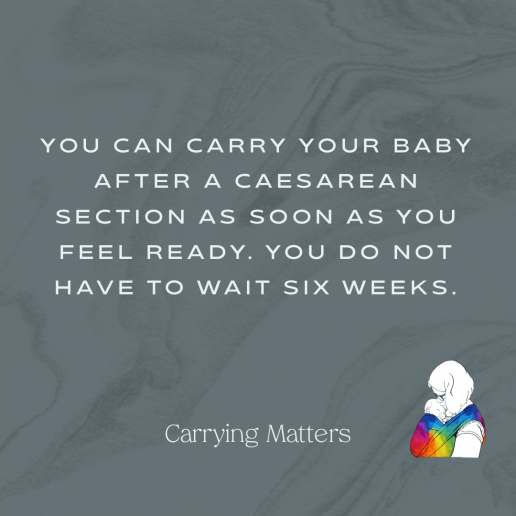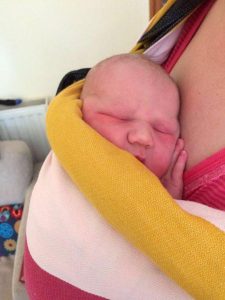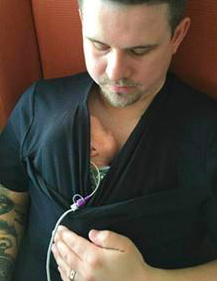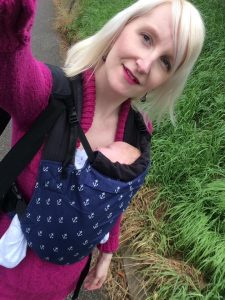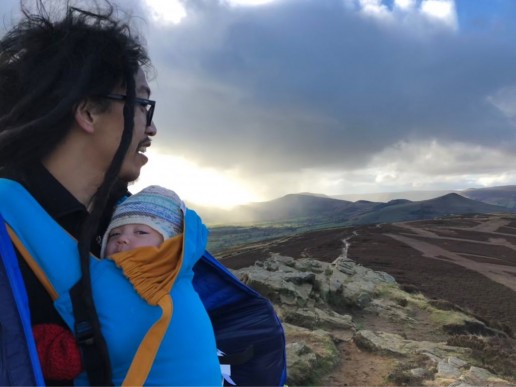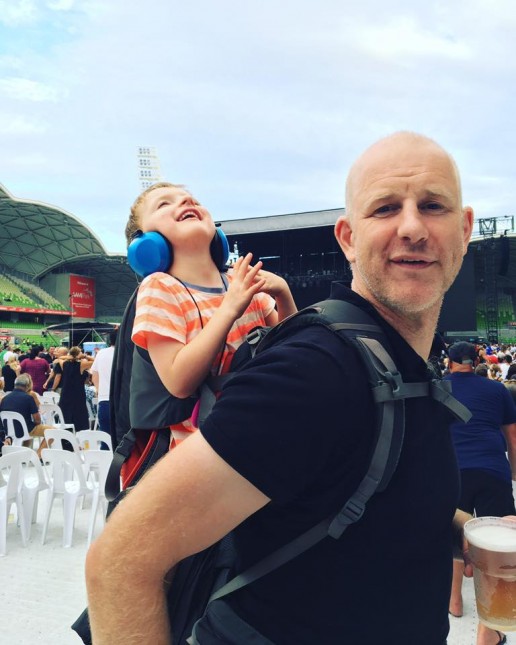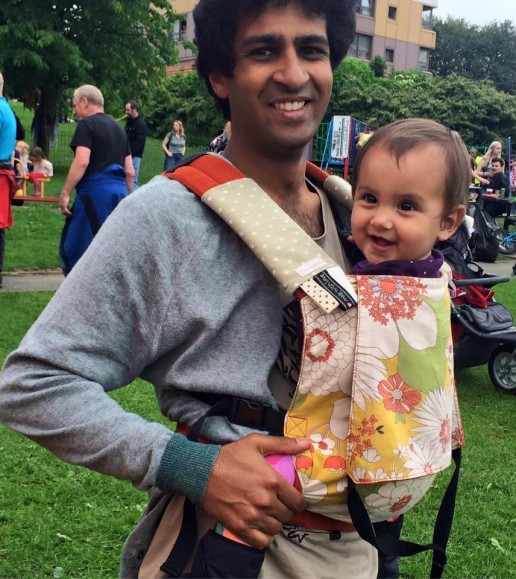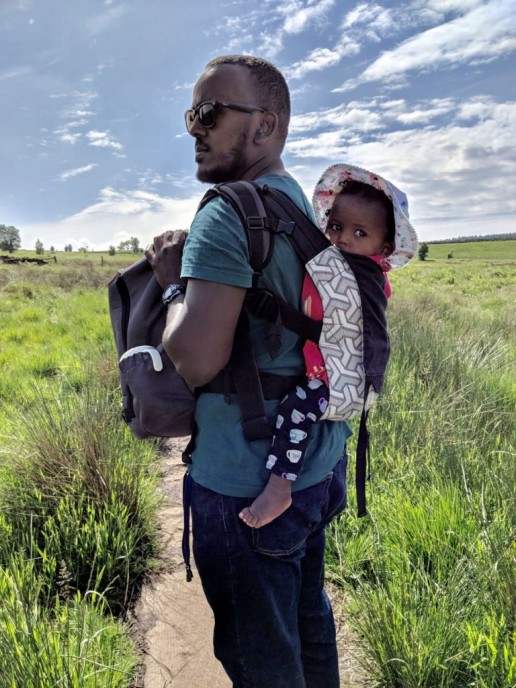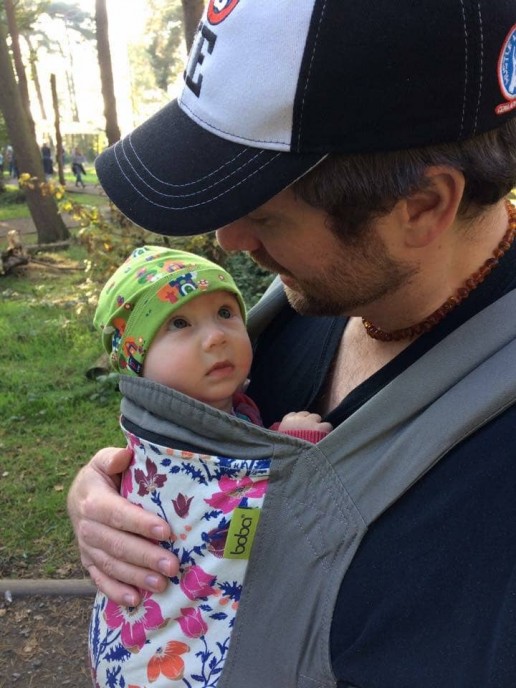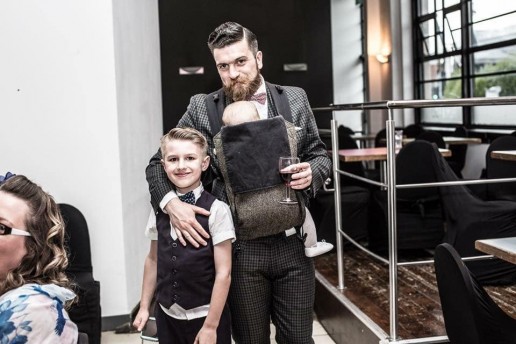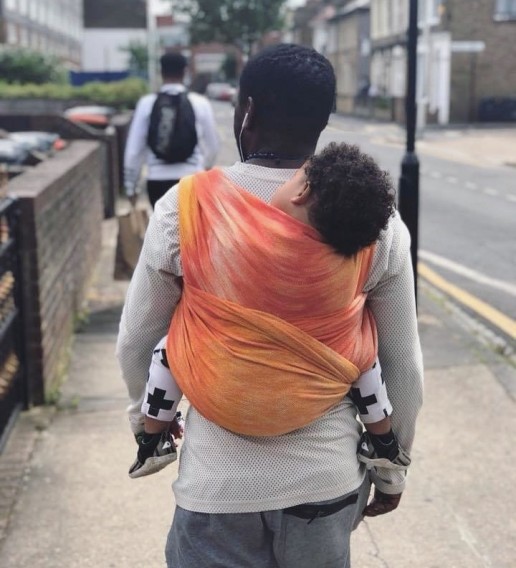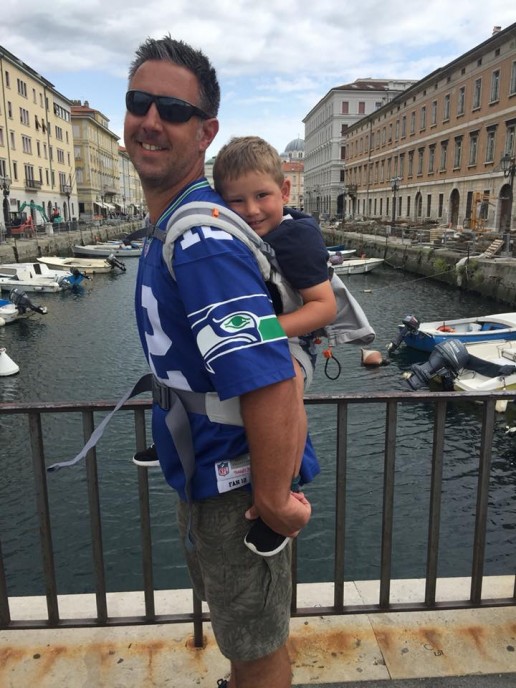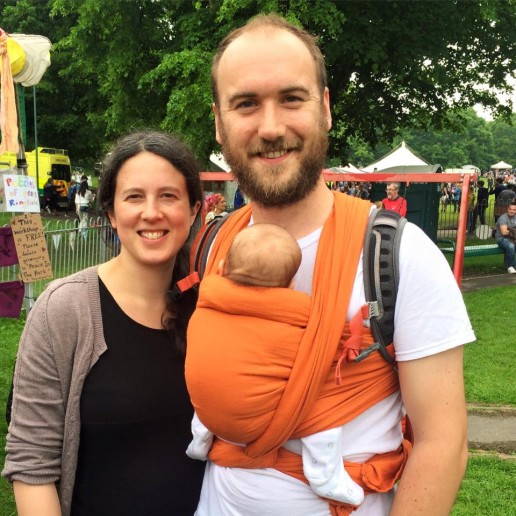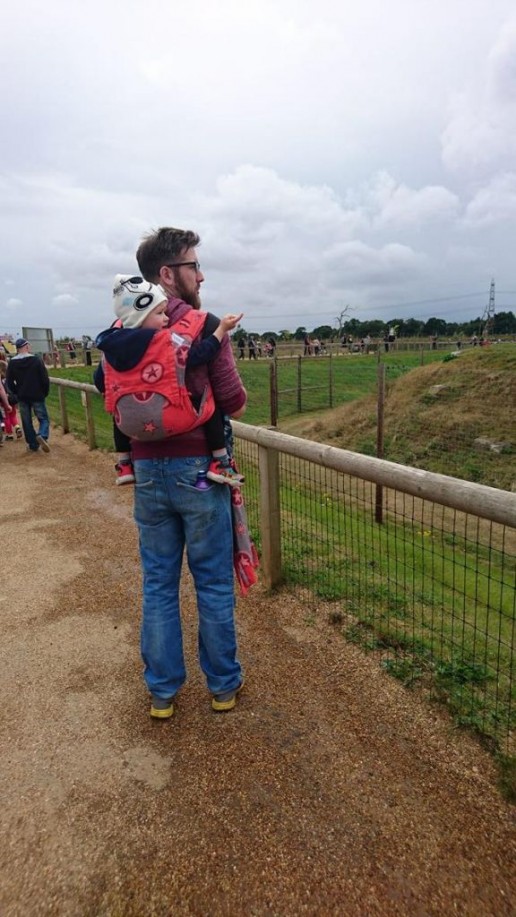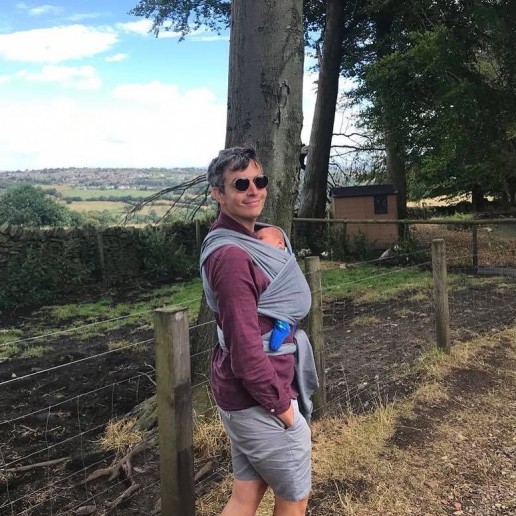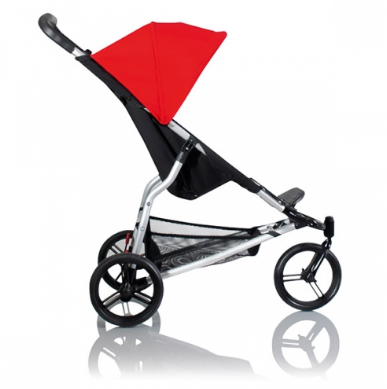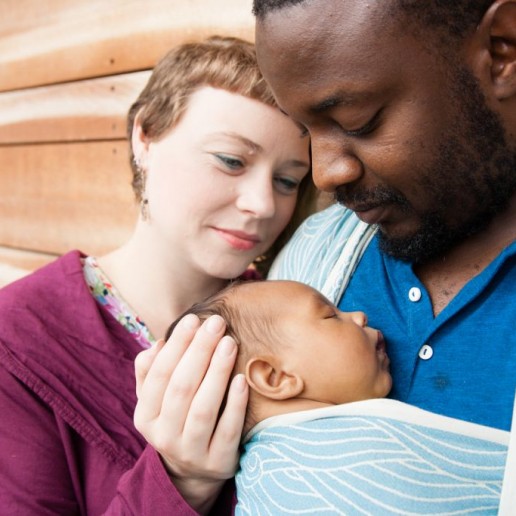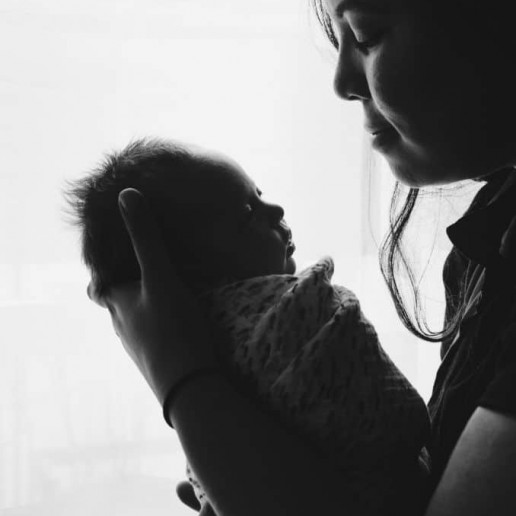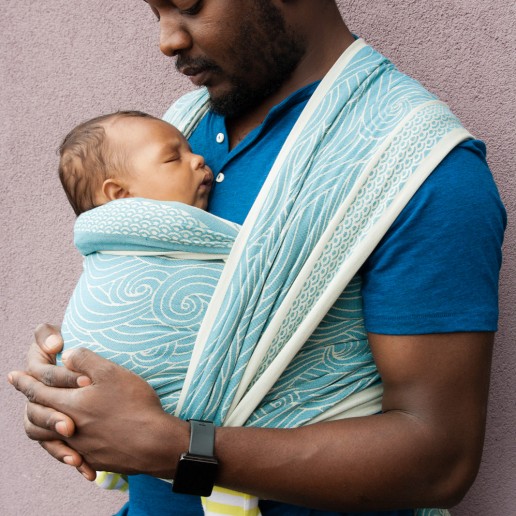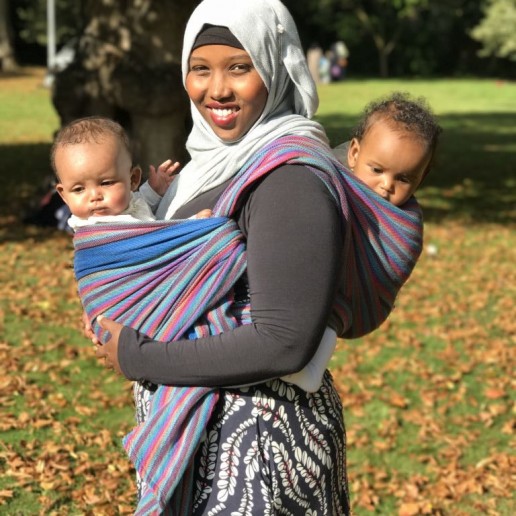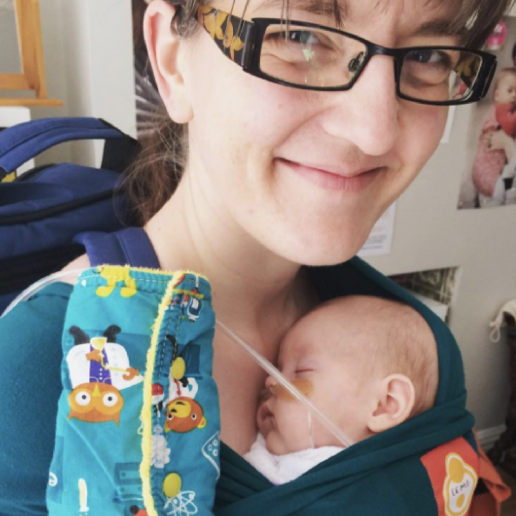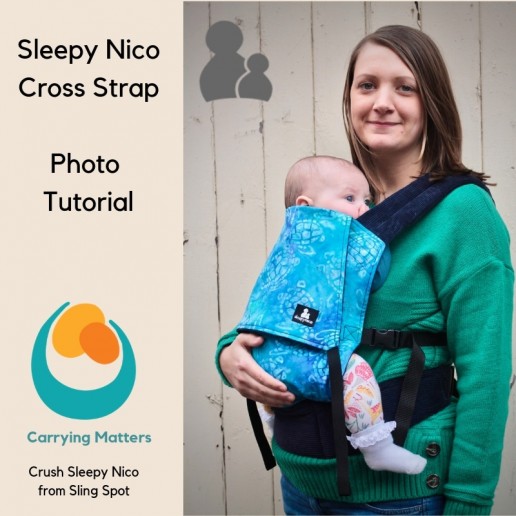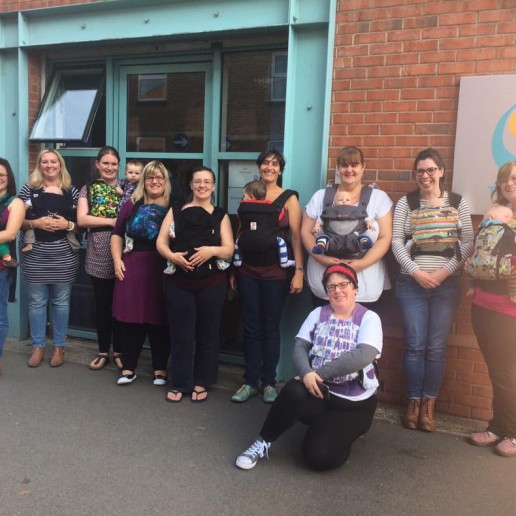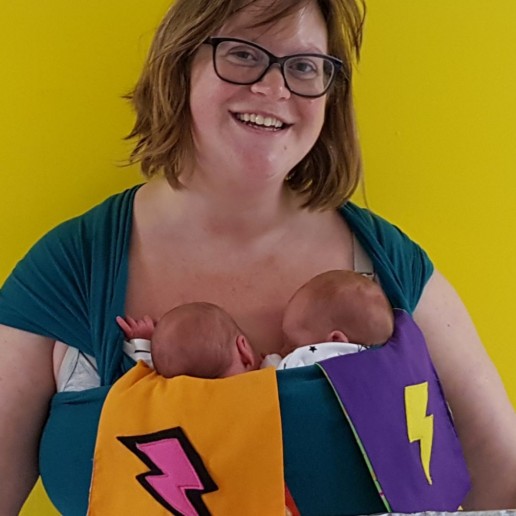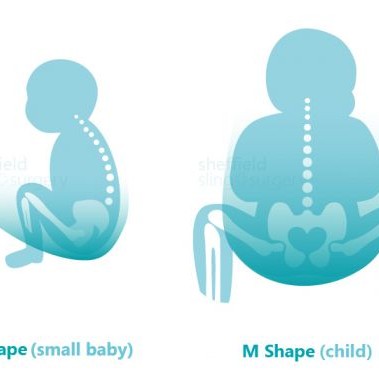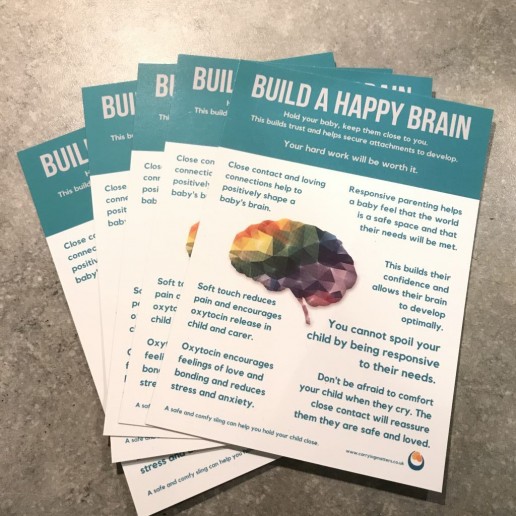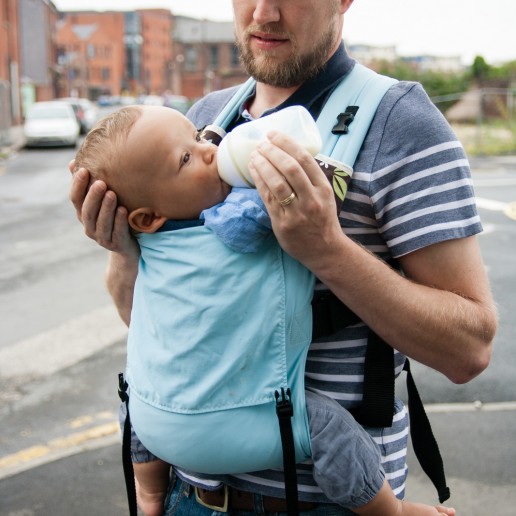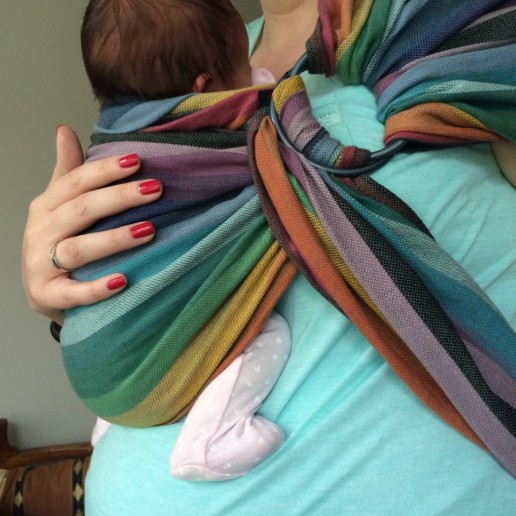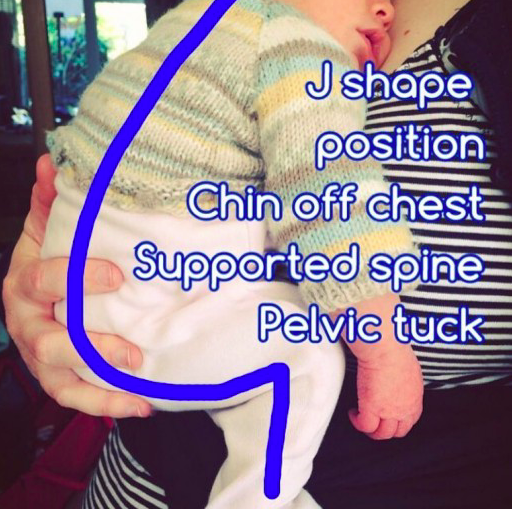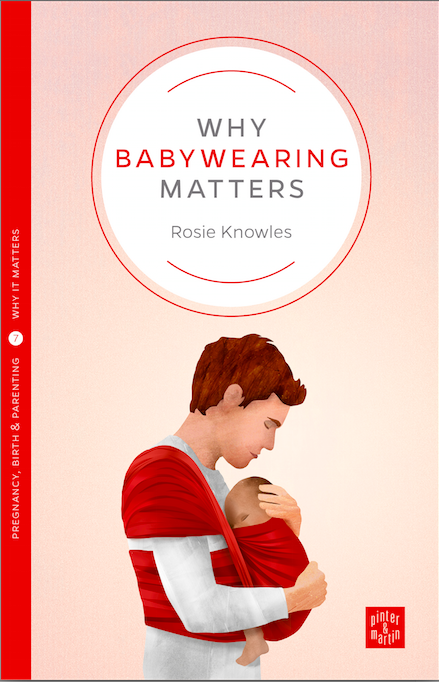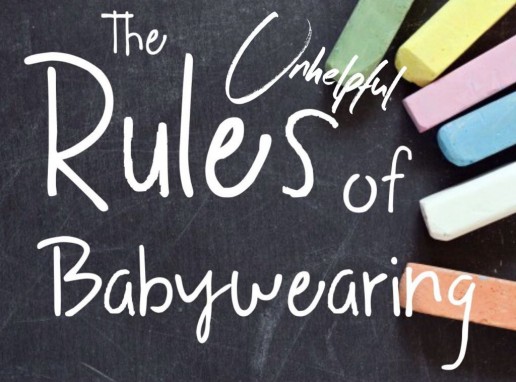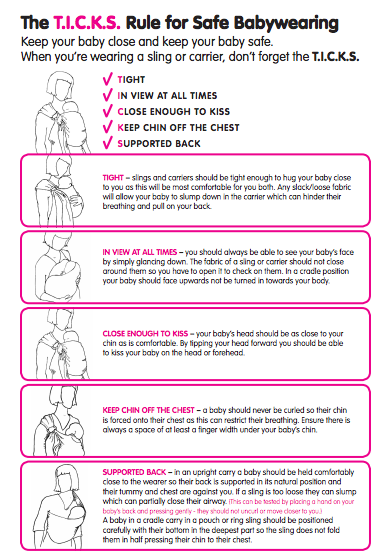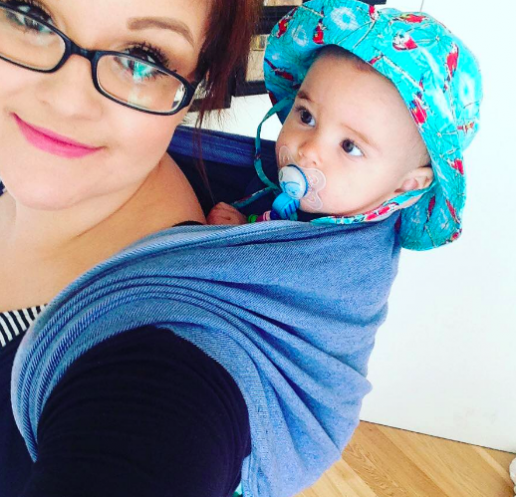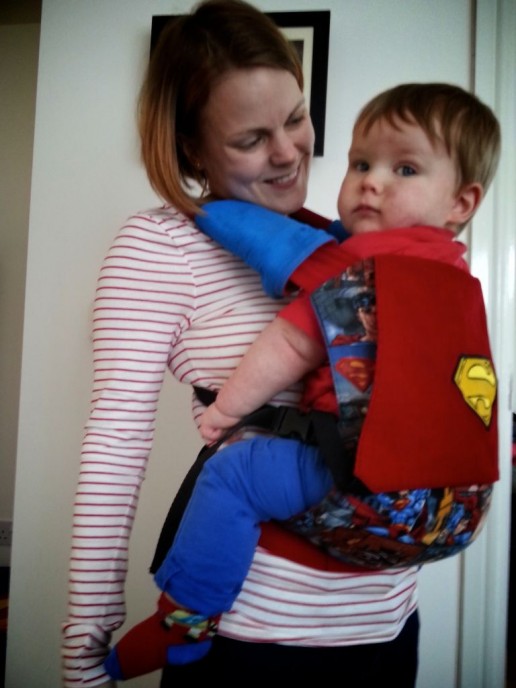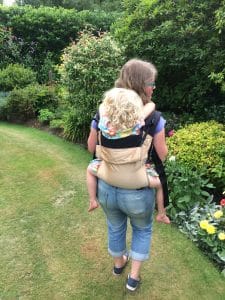The Fuss about Facing Out

What are the advantages of world-facing?
Babies do enjoy seeing the world, especially once they are a little older and have mastered head control and wish to be more involved with their environment, rather than sleeping or snuggling in as they did when they were very little. Curiosity often coincides with increased motor co-ordination and greater periods of awake and interaction time. This is often the point at which families begin holding their babies in positions that give them greater visibility. Instinctively, they tend to support their little ones in very gentle positions that still ensure good hip and spine support; cradled in arms with chin off chest, or held in semi-seated positions with back curved against parent but hips held in flexion, as if sitting in a bowl.
These positions protect the natural anatomical curve of the immature spine and do not straighten it uncomfortably.
As babies grow, their muscle strength increases and fatiguability decreases, alongside greater coordination and gross motor skills. This allows slowly improving head and neck and upper back control (with less drooping or wild flailing) as their spines gradually begin to uncurl. Furthermore, as their focal length improves and visual acuity rises, the world becomes very interesting! There are stages in baby development when babies seem to arch away in arms a lot; this may be related to a desire to see more, but may also simply be attempts to hone upper back strength, in preparation for turning skills and rolling over. This is very common around ten to twelve weeks. Babies may also arch when they are tired, if they have reflux, if they are frustrated.
In-arms holding is responsive, which is the key issue; if baby makes a protesting movement or noise, the carer responds and moves the baby to help it to become calm again. Also, parental arms get tired and baby is easily moved to another position, this may often be on the shoulder facing parent again for a while. Such reactive carrying in-arms, with changing facing-in and facing-out positions, is of great benefit for honing development and also to encourage learning about the world from a safe and comfortable position.
This all sounds great, so what’s the problem with using a sling for this?
What are the hazards of facing out?
It is important to remember that young babies are not ready for prolonged and intense interaction with a very sensory-overloading environment; they have not yet learned how to process the bombardment of information their brains are receiving. They have not yet discovered how to “filter out” the irrelevant for a more focused look at the world, (a skill that we take for granted) so this can be very tiring. Being able to turn away from the noise and bustle and fall asleep (to process information) is important. Babies should NOT sleep facing out.
A facing-out carrier holds a baby in a fixed position for a prolonged period of time. The duration of this time is entirely dependent on the parent; they are unable to see their baby’s face to pick up early cues of tiredness or distress or breathing difficulties, and they are less able to feel subtle shifts in baby’s body signalling discomfort or a need to change positions. Babies can easily be left in carriers for much longer than they would be held in arms.
Babies are intensely social creatures and learn to regulate and control their emotions from interaction with their parents and watching their faces. Social referencing (also known as triangulation) is very important in the first year and well into the second. A child will often decide how to react to a new experience after it has looked to its carer; it will be less likely to touch something dangerous if the carer reacts in an upset way. Potentially scary experiences can defused by turning the head to see a parent remaining calm, or to receive comfort and reassurance, and vice versa. In a structured carrier worn facing out, it isn’t as easy for a baby to twist around to see the parent’s face for reassurance or to be able to seek comfort.
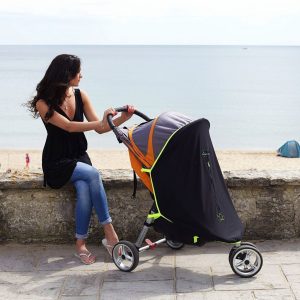
Furthermore, the world-facing positions do not provide any safe sleeping positions (all respected manufacturers say babies must be turned around to sleep; this is often missed in the small print) as there is no head support in this carry. A heavy head that is unsupported by a parent’s chest will droop forwards, putting baby’s chest under slight compression and pressing the chin downwards, potentially compromising the airway.
This is why the majority of respected sling manufacturers suggest that babies under 4months should not be carried facing out. Before this, babies simply are not developmentally ready. Beyond this age, they should not be held in carriers facing the world for longer than twenty minutes to half an hour or so. (Some manufacturers say facing out from 3 months up, some say from 5months up). I think it depends on the child’s personal developmental stage and there should really be no rush.)
There is also the issue of hip and spine positioning in facing out positions. Most facing out in slings is done with “narrow-based” carriers, as very few high street options offer wider, more ergonomic seats that protect the gentle curve of the spine and promote healthy hip development in the world facing position. Most babies find their backs are held in straighter positions than ideal, with their legs hanging straight down from their hip sockets in this narrow shaping. While there is no formal evidence that choosing a narrow-based carrier will cause any harm to a baby who has healthy hips with normal sockets, there is a small percentage of babies who do have developmental hip dysplasia that are missed at their routine checks. These babies will benefit enormously from the ergonomic seated M shape position that allows their joints to be held in the optimum angles for healthy blood vessel growth and nutrient provision, and often this positioning is all that is needed to correct mild cases of hip dysplasia. It is worth weighing up the risks and may be better to choose a carrier that holds a baby more optimally if you decide to face baby out. Additionally, it is more comfortable for a person to be seated on a broad based hammock shaped chair rather than perched astride a narrow padded beam, and babies are no different.
Carrying a baby who is sitting high up against the carer’s body with the centres of gravity closely aligned is much more comfortable than carrying one who is low down, far away, and suspended from the carer’s shoulders. The parent’s body does not form part of the support structure of the carry when facing out, so much of the work of carrying has to be done by the upper body, rather than the core postural muscles. Centres of gravity diverge further when held facing out in narrow based carriers. Put simply, carrying facing out in this style of carrier is often uncomfortable.
Ok, so what can I use to carry my curious child optimally?
It is common among parents who are considering using a sling to look for options that offer world-facing positions. This position is what is often seen in the media and is widely advertised; it may be more pleasing to see happy babies looking directly at the camera rather than away from it, which can be better for marketing purposes. As it is so visible, it becomes the “norm” and carriers that offer this option are often perceived as “better.”
Many parents believe that babies need to be given the opportunity to face the world as much as possible for the stimulation, rather than looking at their parent all the time. Sometimes this belief can be be a marker for low self-esteem in a parent; that they just aren’t interesting enough, when in fact, for many well-attached babies, their parent is their most beloved sight. This is especially true if parent and baby are attuned and the parent is responsive and communicative and able to engage happily in play with their baby. Babies are often able to pick up on unhappy or uneasy feelings in parents and can be reflexively resistant to close contact, creating a negative spiral. Lots of in-arms carrying, skin to skin, and just time spent together can be very helpful with this.
Sometimes babies may begin to resist being carried in their parent-facing positions – they may have come to associate the sling with sleeping which they don’t want to do, and they may want to be able to see more.
To achieve a good view while the child remains parent-facing, and ensure access to the world, try carriers with broadly angled straps that don’t get too close to the face can be very useful, or ones that can be tied carefully for good visibility. As children grow in co-ordination, they need less head support and often enjoy having their arms out of carriers (with the panel reaching up to the armpits for safety and support.) It is surprising how far a child can turn round to see when they can move their shoulders! 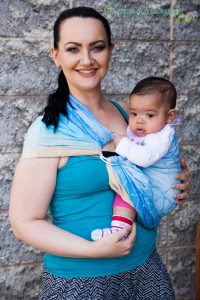
If you have a baby who is developmentally ready for facing out in a carrier and has stable hips, then I think it is just fine to give it a go! Your local sling library will be able to show you some options and talk you through which may be the most comfortable for you. Trying the carrier out first for a period of time at home is very useful to see if it really does work for you before you buy; advice from the internet is no substitute for real life trials.This period of “fussiness” doesn’t usually last long, as babies grow in co-ordination they are happier and many babies who once resisted facing in are very content a few months later in a carrier that is more comfortable with greater longevity.
In summary, facing out can be a great deal of fun for parent and child, if done sensitively and thoughtfully, with consideration to the child’s anatomical development and comfort; look for those carriers that take your baby’s comfort as seriously as yours. Try to pick a carrier that will hold baby optimally for most of the time, some come with specially designed bucket seats and others will widen for facing in and back carrying.
Age-appropriate facing out for those who enjoy it is great, when done safely! Your local sling library can be found at www.slingpages.co.uk.
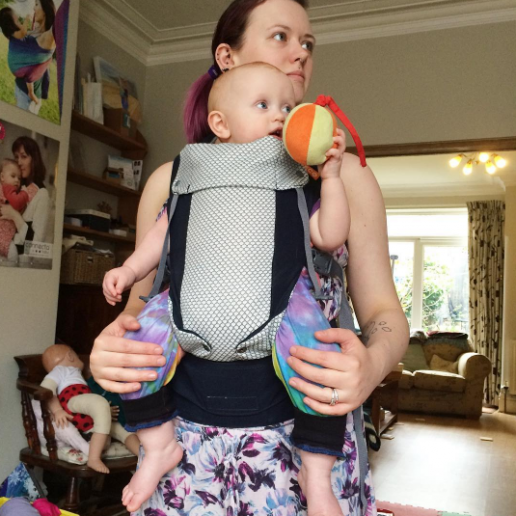
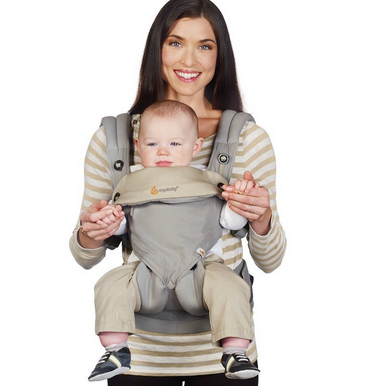
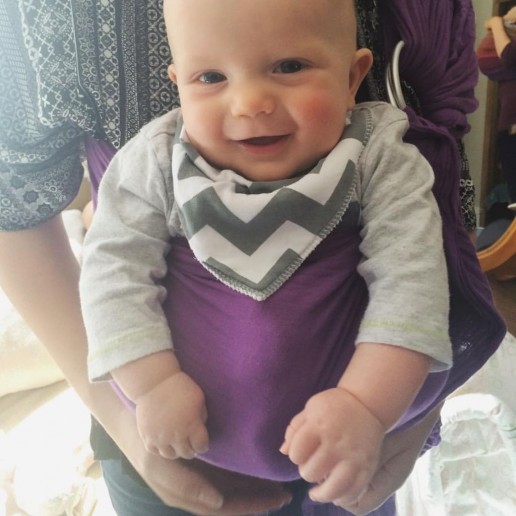
Carrying while Pregnant
Is carrying while pregnant safe? Many mothers wonder if they can safely continue to carry their children while pregnant with a new baby. For many, having established a close bond and finding the carrier they use of great value for comfort and practicality, they are keen to carry on carrying, both to meet their child’s needs for contact and for their own enjoyment.
“I knew that I needed to make the most of carrying my girl before her sibling was born as things were about to change for all of us. She needed me too, so I carried her as long as I could during my pregnancy. Her weight balanced out my bump and actually made my back pain more manageable by being corrective.” Jody
Other mothers may not have a choice, especially if there will be a small age gap between siblings and the older child is not yet walking reliably, or if he becomes worried by the impending changes to the family structure and needs extra closeness and reassurance. Sometimes it is just necessary.
“My little girl is very strong willed so if she wanted up for a carry while I was pregnant, it was simply the path of least resistance . There were a few times when she was poorly, others when she was tired or I simply had things to do. It was all about practicality and doing whatever made my day a bit easier.” Lindsay
It is worth reflecting on the fact that women around the world have, for many generations past, carried older children on their bodies while pregnant, so it is certainly possible to do. In societies where babywearing is a part of everyday life, child-carrying is traditionally shared around large families, with older siblings carrying younger ones, or close family members taking their turn, to lighten and distribute the load around the community. Women in more Westernised societies may feel much more isolated and unsupported by their local communities, so they may need to be able to carry their own children for longer periods and more often than in traditional societies.
Babywearing in pregnancy is indeed possible for the majority of women, if they are in good health and there is no medical reason to avoid lifting loads. Those who are already well used to carrying their toddler frequently will find it simple to continue; their body strength and tolerance has grown in pace with their child’s weight and little may need to change until the bump is large.
“We needed to walk the dog and I wanted to be able to go to the dog trials and carrying was much more convenient than a buggy. My body was used to carrying, so we just carried on!” Lucy
Those who are new to carrying (and looking for a solution for an uncertain or distressed older child) may find it more of a challenge, just as if they had a new job which required sudden frequent heavy lifting. In these circumstances, it would be wise to get some support from your local sling professionals to find out which slings will work best for you and be comfortable. They can help you learn how to get your bigger child up into a carrier safely without straining yourself, and be able to work with you to find solutions. Once equipped with an appropriate sling, it is wise to stick with carrying for short periods and gradually increase the duration of use. This all helps to build up endurance until pregnancy is well advanced.
First Trimester
The maternal body undergoes several changes during pregnancy which can have an impact on the type of carrying women find comfortable.
In the first trimester, symptoms such as 
All being well, however, most carriers can be used in early pregnancy; there is no need to fear that the growing baby will be squashed by waistbands, for example. On the whole, the carrier that has been used up until a mother discovered she was expecting again can continue to be used while baby’s body is still small and mostly contained within the pelvic brim. Front carries are still fine to use and hip and back carries are also appropriate.
This may be a good time to begin learning some new carries or investigating other slings in preparation for an enlarging bump. At this early stage, the toddler’s weight is still being distributed around the mother’s body and it is not resting on a bump, so there is time for both parties to begin initiating change whilst still being able to enjoy front carries.
If there is any discomfort from abdominal pressure, altering the type of carry can be very useful; front carries that don’t use a waistband could be considered, as could hip carries or back carries that avoid any central abdominal pressure. Meh Dais (and their variants) and woven wraps will offer high back carries in this circumstance, and can be tied in ways that have no knots around the middle at all (for example, “tying tibetan or candy cane”). A carrier with a waistband could be moved low down to settle around the hips (as long as the carried child remains snug and close enough to kiss with an uncompromised airway), or moved higher up nearer the ribs, whichever feels most comfortable.
Second Trimester
As a growing bump begins to have an impact on a mother’s shape, moving to hip or back carries may feel much more comfortable. Front carrying may become awkward as the child will be very high and it is best to avoid a heavy toddler’s weight sitting on top of a bump.
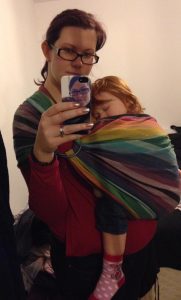
Those who love ring slings and other hip carriers have often already learned how to minimise these alignment issues with familiarity and experience, and can always benefit from being reminded!
It is worth being aware that prolonged hip carrying in pregnancy may also have an impact on the pelvis and its stability, especially as ligaments begin to soften and loosen in preparation for birth. If you begin to experience any discomfort with carrying (if not related to inexperience) then it is sensible to check your posture to make sure your spine is not twisting, try frequent switching of sides, reduce the duration of carrying, and see your local specialist for support. Some women suffer from Symphysis Pubis Dysfunction and may find hip carrying inadvisable.

Logistically, waistbands may begin to become difficult to fit above the bump and may no longer be as supportive due to the changing angle of the band and how it functions when distributing weight around the pelvis. It is up to the individual to decide when the waistband is no longer the best option. At this stage, carriers with floppy soft waistbands that will mould around the mother’s shape, or no waistband at all, may be more useful. Meh Dais with flexible waists that can be carefully tied, or podaegis or onbuhimos or woven wraps tied in such a way that the carry has no waist at all may be very helpful.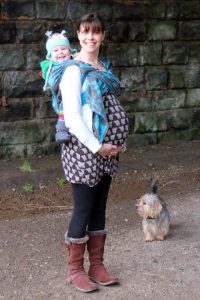
Learning how to do this well and comfortably may need practice and building-up of strength due to the new position and a local sling professional can help.
 Third Trimester
Third Trimester
In this last part of pregnancy, the maternal body is now carrying a significant extra load every day; movement may feel more cumbersome and the mother may wish not to carry any more than she has to. Furthermore, the levels of relaxin hormone increase significantly; ligaments and tendons soften and become more elastic. This helps the pelvic outlet to widen ready for delivery and also loosens and softens the intercostal muscles and ligaments between the ribs to allow expansion of the chest diameter for the growing baby. These changes will all affect load-bearing and every pregnant mother will vary in what she feels able to do; each successive pregnancy will also affect carrying ability.
In the third trimester, high, supportive back carries with soft slings tend to work best; woven wraps in multiple layer carries or supportive single layers are useful, as are meh dais and their variants, as well as the waistband less onbuhimos, all of which keep toddler weight high, snug and central, minimising any uneven pressure on the pelvis and spine, and also balancing out the weight of the bump. Carrying may be only for short periods, and hip carries are best kept to a minimum.
Once baby has been born, the maternal body will take some time to recover from the huge changes of preparing for labour; and then the process of labour and birth themselves. It may be some time before a mother feels well and strong enough to begin carrying her toddler again; the pelvic floor and stretched abdominal muscles need time to re-tone and strengthen. For this reason, many experienced professionals will advise post-partum women to consider carrying just their newborn for the first few weeks and months, and then begin to carry their toddler again in front carries before they consider re-starting back carrying. Methods for getting a heavy toddler on the back will need to be considered; swinging and scooting methods may place inappropriate strain on still-recovering ligaments and muscles. This will of course depend on individual circumstances; back carrying may be preferable to pushing heavy buggies. Tandem carries may be necessary from an early stage, and it would be wise to visit your local sling professional to get some support with carrying two children in this way if you are not experienced.
Carrying in the Postnatal Period
Is carrying in the postnatal period (in the early weeks after a baby is born) safe?
Babies want to be held close from the very moment they enter the outside world; they crave contact and many will spend their first few days and weeks sleeping in their parents’ arms and feeding frequently, enjoying this close interaction.
Pregnancy can be tiring and uncomfortable for many, due to our changing bodies and habits. We are no longer an upright species but a sedentary one, to our great anatomical and physiological disadvantages; chronic pain is a significant problem for increasing numbers of people in our society. Symphysis Pubis Dysfunction can be debilitating for pregnant women, and there is a growing belief that many women’s bodies are frequently not in the optimal condition to carry a child and thus take much longer to recover from pregnancy than our forebears. Ligament softening and laxity (from the hormonal changes preparing a body to deliver a fetus) can take some time to resolve fully especially if there has been pre-existing back pain and poor posture, and breastfeeding may prolong the effects of relaxin.
Labour, while exhilarating and empowering for some, can be exhausting for others, especially if prolonged. The recent historical practice of lying down for delivery is in marked contrast to how most women around the world across history and cultures have given birth (upright, squatting or kneeling). The natural birth movement and the emergence of doulas to support women with their delivery choices mirrors a growing desire to get back to our ancient human roots, which may also encourage speedier recovery from labour and birth.
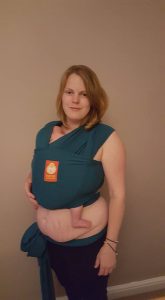
The rate of caesarean sections (both planned and as emergency) is high in Western society, currently between 20-25% of births in the UK (with some regional variation). A caesarean section is major abdominal surgery and some recovery time from this is to be expected, and varies enormously from woman to woman, depending on the reasons for the operation. Women are advised to avoid heavy lifting, “carry nothing heavier than your baby”, and not to drive for at least six weeks after birth. Scars can be uncomfortable and slow to heal for some, and some may experience abdominal pain for a while afterwards. Babies may come early and be very frail for several weeks.
Therefore it is not surprising that many mothers worry that after labour and birth, they may not be strong or well enough to carry their newborns in their arms for prolonged periods. Many will have toddlers at home needing the reassurance of their mother’s loving arms to help them cope with the newcomer’s arrival. Paternity or parental leave is often short; in a few weeks mothers are often required to manage at home alone.
Carrying your child in the postnatal period is important.
The early weeks are vital for bonding and attachment, providing continuity and security, promoting breastfeeding and helping to reduce depression. So yes, we should carry our babies somehow after birth. This doesn’t need a sling; people can hold their babies while sitting down and while reclining just as much as while they stand and walk around; it is the closeness and the contact and the skin to skin that promotes bonding and oxytocin release that matters. It helps to shape baby's brain, and also has a positive effect on yours! Furthermore it can be a great way to ensure any older children still feel connected to you, as your hands are free.
Carrying a newborn baby can be very healing if birth has been traumatic or there has been previous bereavement.
“"I had a tiny baby (4lb5oz) and experienced a traumatic birth, I suffered with PTSD. At times this meant I was very anxious and wanted to keep my baby close to me to be sure she was safe. I started with a stretchy wrap when P was just 3 weeks old. I truly believe babywearing strengthened my attachment with her and helped me to cope every day." Anon
There are some garments of clothing that can be worn in hospital or in the early weeks after birth; mimicking the practice of putting a tiny newborn down the front of the shirt. Some of these garments (known as skin to skin tops or kangaroo care clothing) are designed for keeping baby skin to skin to the parent while reclining, and are not hands-free.
Others are a little more structured (at least two layers of stretchy fabric) and provide enough support for baby that a parent can be hands-free and walk around, similar to a stretchy wrap. These can be most useful in hospital environments for their coolness and simplicity.
Please note that if your baby is premature or very small (under 6lb) it is wise to seek the advice of a specialist baby-carrying consultant; many "newborn" carriers, including some stretchy wraps will not provide enough support without guidance on how to use for these babies with special needs, and many buckle carriers will be much too big.
Breast and bottle-feeding can cause back, neck and shoulder pains, as can prolonged periods of one-sided carrying (which can also affect the pelvic floor and the symphysis pubis.) Being alert to the body’s signals of discomfort and acting on them to frequently redistribute the strain is of great benefit in building up tolerance and strength.
As women recover their strength and are able to do more each day, their mobile carrying abilities will grow too. As womens’ bodies settle back down after pregnancy, with appropriate pelvic floor toning and correction of posture and alignment, carrying will become easier. Furthermore, as baby gets bigger and heavier, the parent’s muscles will adapt to the gradually increasing weight and become more toned day by day, the more often they carry.
“Much of my pre-pregnancy life was spent in the mountains, and carrying my babies after their birth helped me get back in touch with my "home". It enabled me to very gradually and gently regain some fitness away from busy streets, and felt like less strain on the scar area than pushing a double buggy uphill.” Carissa

Keeping a baby’s weight high, snug and central will encourage loading across the large weight-bearing axes of the body, thereby preventing strain on muscles, ligaments and the pelvic floor, and avoiding abdominal pressure. Lifting a baby to the chest should be done carefully, with knees bent and upright posture maintained, and pelvic floor and core muscles engaged and active. Most types of carriers will be possible to use after a vaginal birth, and it will be a very individual and personal choice which. On the whole, most babies enjoy the gentle all-around pressure of carriers that can mould softly around them and be reminiscent of the uterine walls they have just left; and carriers that distribute weight widely across the parent’s upper body will be more comfortable.
If you have a sling that makes your back ache, please visit your local sling library or consultant for a fit check (often a few tweaks make all the difference) or to try an alternative. Cheaper carriers from supermarkets/Ebay often work much less well than better designed carriers and therefore last much longer. "My baby is too heavy for a sling" is usually an issue with the sling not fitting/not being well designed.
Carrying after a Caesarean
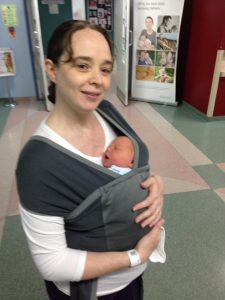
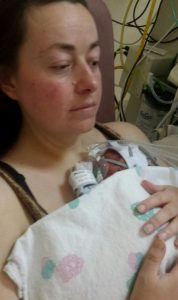
This is also very possible, and it could be argued, perhaps more important post section than after a normal non-instrumental vaginal delivery, depending on how the individual feels after the surgery. Achieving skin to skin as soon as possible is ideal, for promoting oxytocin release and bonding. This is vitally important after a section, especially if it was emergency and traumatic, thereby interrupting many of the biofeedback mechanisms around bonding. It is also important if the section was planned and baby was thus delivered before the biological hormone cascades of labour and birth were able to begin. There can be a strong tendency for women who did not have the birth experience they wished for to feel robbed and deprived of an important part of their baby’s arrival. The subsequent feelings of sadness and grief, or disappointment or that they have let themselves or their baby down somehow, however untrue, can significantly hamper the forming of attachment bonds and play a part in later postnatal depression or other mood disorders.
Mothers who experience this are very likely to find that skin to skin contact and frequent close touch and carrying extremely useful; the process of initiating and mantaining contact and loving touch often acts as a catalyst for the oxytocin release; this positive feedback mechanism will encourage loving feelings to develop despite the less than “perfect” start and get bonding well under way.
As soon as surgery is safely over and a well baby can be given to its mother, skin to skin can begin; resting on the mother’s chest under a blanket, inside a shirt or with kangaroo care clothing. Women are entitled to this skin to skin and should insist upon it; baby does not need to be washed or the cord to be cut before contact is achieved; the sooner the better.
Once mother is ready to move around and carry her child in her arms she can; she is advised to carry nothing heavier than her baby. Some women will choose to use slings immediately, if they feel ready (especially if they are already familiar with slings and feel confident with their use), others will wish to wait, especially if they feel unwell or are in pain. If the mother is confined to hospital and alone for parts of the day and wishes to move around, she may find the sling will help her to feel safer than carrying her baby loose in arms while she is still a little unsteady.
“Having a sling for carrying was very useful, as much easier and less painful than carrying in arms (less stress on abdominal muscles). It was great for bonding, especially since we were having trouble with breastfeeding.” Rebecca
The key factor is to avoid any carrier from irritating the wound or putting pressure on the abdomen. Double layer kangaroo-care shirts or other soft carriers such as stretchy or woven wraps, high-carrying waistband-less meh dais or buckle-tais and ring slings in frontal tummy to tummy carries, may be options to consider. Baby’s legs should ideally be tucked into the M shape, and this will also help to avoid feet kicking against a still tender wound. As the scar and any abdominal pain heals, carriers with more structured waistbands will become more accessible.
General tips about post-partum carrying (including fitness classes)

Participating in postnatal recovery programmes can be useful; however combining carrying and exercise/dance is usually best done with great caution as not every provider will have adequate knowledge about postnatal recovery (pelvic floor and diastasis recti issues) or about the rate and speed of each woman’s individual recovery from birth. Many may have no specialist knowledge about safe sling use or how to protect a baby from sudden shaking movements, as well as how to avoid overloading still-recovering tissues with certain stretching or weight-bearing activities with the extra load of a child in a sling. Walking with a baby in the sling, ensuring good alignment and posture, gradually increasing the speed and duration, is usually enough exercise for most women in the early months. Please do not rush; pelvic floor dysfunction is very very common (14 million women in the UK are known to have an issue, and many many more never seek help and remain undiagnosed). Leaking is NOT normal or to be expected. If you are unsure if your pelvic floor is recovering normally, please see your GP.
Read more about babywearing fitness classes here.
Using a sling allows families to settle back into the normal rhythms of daily life.
Often, older siblings are uncertain about the new addition to the family and uneasy about their place in it; they may need extra reassurance with the birth of a new baby. They may wish to return to their mother’s arms and be close to her body, for reassurance and reinforcing of the attachment bond.
Toddler carrying after birth
“During the intense post-birth bonding period with D I began to use a couple of wraps that had been favourites of R (the new big brother). It almost felt like a betrayal! But one afternoon, R asked if he could come up for a front carry in his favourite wrap, something he hadn't done for ages, and we twirled round the lounge together laughing while my husband cuddled the new baby. I think that was a really healing moment for us and let my eldest know he still had an important place in my arms too.’ Emma
However, toddler carrying after birth is much more of a challenge, especially if the pelvic floor is weak and there is diastasis recti (separation of the abdominal muscles from the stretching during pregnancy). Please seek help if your floor or core are weak.

Involving the whole family!
The post-partum period may be a great opportunity for other caregivers in the family to share the carrying and begin the bonding process. Whole families thrive when children are kept close; it spreads the load of child care around. Partners can carry their newborns, or their older children to provide reassurance.
“Carrying our eldest son (3) enabled my wife to give her attention to our new baby. It gave us much needed daddy and son bonding, at a time when he was feeling insecure with the arrival of the new baby.” Mal
Remember, it is the closeness and contact that matters; in arms carrying is as valuable as using a sling, and the shifting of your growing baby around your body as your muscles tire will help to rebuild your strength and endurance. Sharing the carrying with other members of your family will help to strengthen relationships and reduce the strain on your own body too.
Carry Me Daddy!
“Dear Daddy

When you hold me I feel happy. You are strong and I am safe in your arms. The more time I spend with you the more I trust you, and the more I can let you look after me when Mummy isn’t here.
I love to hear your breathing and the sound of your voice rolling around in your chest. I can hear your heart beating and it steadies me. I can hear you best when I am close to you. I love it when you look at me with your proud eyes, it makes me feel good. I feel loved.
I love being carried on your chest where we can chat till I am ready to snuggle contentedly to sleep.
I love my rides on your shoulders and on your back. The world is so interesting from up high!
I love the games we play and the way you make me laugh till I have no more breath in my body. I love it when you hold me on your lap to read to me. I love it when you hold my hand.
Carry me Daddy, while you still can!”
In-arms carrying and all other means of close and regular contact (such as noisy physical play) is of enormous value in building bonds between fathers and their children. 1 in 4 children lack strong attachment relationships, and slowly our society is recognising the need to address this. In arms carrying can be hard work, and a good comfortable baby or child carrier can make this much easier. Babywearing dads are becoming more and more visible, which is great news for families and for our society.
There can be a common myth that is only mothers who bond with their children in depth, and that the changes in her brain with parenthood are unique to her. This isn’t the case, fathers’ brains are also deeply affected by their caring role and they form strong, lifelong connections to their children if they are closely involved with their young baby as they grow. Bonding can be encouraged in many ways, not just though feeding the baby (which is another common myth). Babywearing is one tool for developing a deep relationship.
Here are some fathers talking about babywearing, what it means to them and why they do it!
Mohamed
Babywearing! How are you faring? Are they still staring? As a father of twins who liked getting things done, there was only so far my two hands could take me when I had two babies to hold. I was hesitant at the science behind stretchy slings when I was first told you could carry more than 1 baby in them, the picture shows how quickly that evaporated into pure elation and joy. "I've got my hands back!" I remember thinking. That was the start to an awesome journey where there was nowhere I couldn't go with the twins. Beyond the physical strength which babywearing gave, I feel like it helped me show my girls that no matter what, I was able to lift them and raise them above whatever it was they were facing and give them a different view while still supporting myself. Why are you fearing if all you are doing is baby wearing?
Slings and Prams and Guilt
“I have a confession to make. I like my pram; sometimes I choose it over my sling. Does that mean I’m not a real babywearer?”
“I feel guilty if I pick the pram for days out when I know the sling is so beneficial.”
“I feel selfish if I use the buggy, but sometimes my body needs a break.”
Slings and prams and guilt often seem to go hand in hand; as if there wasn’t enough guilt involved in being a parent in the first place.
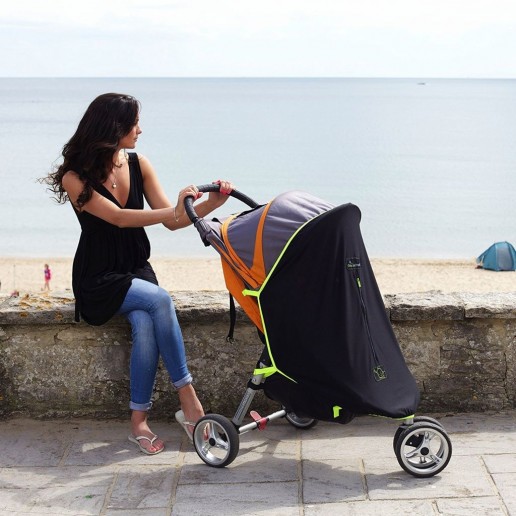
I hear phrases like these from time to time, and while I am delighted that these families have discovered the good things that come from using a carrier, I feel sad that guilt has started to creep in, and that divisions are developing. There is more than enough guilt in the world for parents; how they choose to feed, how they choose to dress their children, and now it seems, how they choose (or don’t choose) to carry. I am really keen to prevent any “mommy wars” regarding carrying from springing into life, so here are my answers to this sort of situation.
Carrying DOES matter. Carrying your child is an important and necessary part of the “fourth trimester” early months of life, it is part of the essential bonding (imprinting) process whereby attachment is created. Secure attachments with a loving caregiver are the bedrock of future positive mental health and the springboard into healthy emotional relationships in later life. For young babies, loving touch and holding are one of the major means of providing this sense of being loved and being secure. Few of us are able to resist the urge to hold our crying children, to provide them with relief and to be their safe space, it is instinctive in us. We should all spend a lot of time holding and loving our babies and allowing them to learn to love us back.
However, modern life is demanding and society encourages us to think that early independence is desirable; that children should not “hold us back.” It is important to care for all members of the family; baby, siblings and parents equally; and this is where using a sling can help. A baby needs to be carried; a sling will allow this to happen while life can continue around them. A sling can mean the childcare can be shared with other adults, a sling will allow a parent to get out and around without the need for lots of equipment.
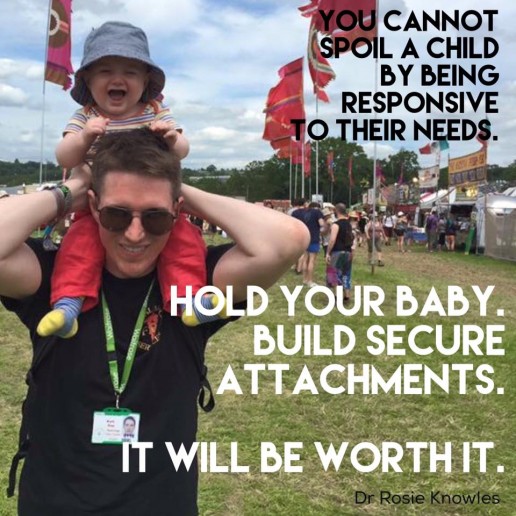
That said, there are many ways to keep a child close without the need to use a sling 24 hours a day. In-arms carrying, cuddly play, breastfeeding, bedsharing, piggybacks, reading stories with baby on your knee and so on are all ways to be in close contact. It is indeed vital to keep up with regular close contact well into the 2nd year and beyond as our children’s brains are still learning about love and attachment – it’s an investment in their future mental health. However, once babies begin to take control of their own bodies and learn how to move they need the freedom to do so.
Prams and buggies are a perfectly valid, convenient and useful way of transporting your child around and there is no reason to feel you are disadvantaging your child by using one instead of the sling today, or depriving her of something, especially if she can see you and remain in communication. You can meet her needs for closeness some other way later in the day. There is no reason to “ditch” the pram if you find it helps you in your parenting. A pram is (like the sling) a tool for getting around and carrying things, and may be easier in many circumstances, just as a sling can be easier in others (eg public transport, busy shops, off-road exploring). There are many ways to carry other things when your baby wants to be up; special bags that fit around the sling.. or a buggy!! Many families use and love both types of transportation, choosing what will suit the situation best.
Some children may just prefer the space of the pram; this is not a rejection of you, but may just be an expression of their personalities or their wish to explore what they can do with their limbs. It may be that your little boy feels too hot in the carrier that you have, or just fancies a change! Your toddler may also enjoy being able to see the world from a different perspective. If your baby loves the pram and doesn’t want to go in the sling today (assuming of course it is a comfortable and well fitting one – see here if your baby seems to hate the sling), that’s just fine. You are being responsive to your child; there is nothing to feel guilty about.
Sometimes YOU may just prefer the pram over the sling, especially if you are feeling a little claustrophobic or touched out, or just tired. Maybe you have two children, or more, and the buggies are the best option!
We don’t live in the same supportive communities these days and it can be hard for one (or two) people to shoulder the load of responsive parenting alone 24hours a day, we all need a break sometimes. “Villages” of old would share the carrying/ feeding/ entertainment more widely, which provided a much better balance of life than many of us are able to find today. If you want to use your buggy, use it and enjoy it, you can cuddle your baby later (or you may have already used the sling today.) Do not feel guilty that you are not being the best parent that you could be.
Do not feel guilty if you feel you just can’t carry today. There is no such thing as a perfect parent and social media sharing doesn’t present a true picture of people’s lives; it can look like others are using their carriers hour in hour out, day after day from their photos, but these don’t show the in between hours or days where the sling is not in use (and the pram is!) Sometimes prams are an expression of our personalities too, just as the carriers we choose can be…
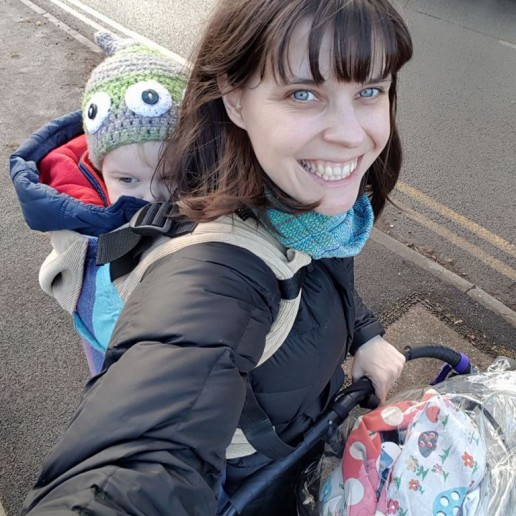
All safe and responsive carrying is good
; the sling you choose to use is not important, as long as it is safe and comfortable. A buckle carrier is as valuable as a mei tai or a woven wrap or stretchy or a ring sling. Even brands of buckle or wrap is irrelevant; what matters is that you and your child are together, in close contact, safe, and enjoying each other’s company, or sleeping in contentment.
If you are a sling user, this is a great opportunity to avoid creating a culture of guilt and judgement. The parents you see using a pram to quieten a crying baby may well have found this works better for sleeping than their sling. The mum you see pushing a pram in crowds may feel her baby is safer inside the pram than being bashed by passers by in a sling. A parent carrying a heavy toddler in their arms after a melt-down may well have chosen not to use their sling today. iIt is important to be kind and recognise that one moment is not a whole life, and we do each other a dis-service if we unintentionally spread the message that either prams or slings are superior, or if we stare and make comments about others that could be overheard. All safe slings are of great value, and we should be cautious about what message we send to the new parents around us.
I’ll finish by reiterating that carrying IS important. We should all carry our babies and spend as much time in close contact with them as we can, be that in a sling, in arms, hand holding and so on. We should try to carry our children as much as possible, as there are many good reasons to do so. That does not mean that we should feel guilty if we choose to use prams or buggies as well, or if we choose to use one kind of sling over the other.
Oh, and of course it is fine to come to a sling meet/sling library session with your pram! And no, you definitely don’t need to feel embarrassed if you see me out and about and you are using your buggy!
Carrying Matters - all about babywearing safety, a guide to slings, and why connection matters
Welcome to the Carrying Matters website, run by the award-winning Dr Rosie Knowles.
It is important to support caregivers as they build a happy brain for their children. Soft touch and loving connections play a vital role in this. There are so many benefits of babywearing, which can be explored in this site. Babywearing safety matters; my guide to slings and my commitment to sling education will help parents and those who support them feel confident with sling use at every age.
Listen to Rosie talking about the 4th Trimester period in a new family’s life.
Search my website here
The positive effects of soft touch, close loving contact, and meaningful connections are enormous, and investment early on in family life is well worth it. Holding and carrying is connection; it matters to children, their carers, and society. The close contact helps to build a happy brain, and creates the relationships that buffer against adversity and promote resilience and long term positive health outcomes. It also helps mothers to survive the “4th Trimester” period and the months and years ahead. Here you can find everything you need to know about how to carry your baby safely and well, why babywearing is so normal and useful, how to choose a baby carrier, and help for all sorts of circumstances.
This page is run by Rosie Knowles, the author of the book Why Babywearing Matters (you can get a signed copy here). She is a GP in Sheffield, a carrying advocate and babywearing expert. She is passionate about supporting parents and carers to be close to their children; holding, soft touch and carrying matters in so many ways.
Recent Blog Posts
- Arms In or Out?
- Journeys to Recovery?
- Carrying a child with congenital heart disease, Abbie’s story
- Adversity and connectedness in the early months
- Parenting Criticism
- The importance of soft touch for infant development
- Babywearing in the time of Coronavirus
- “Babywearing for All”- helpful or harmful?
- Carrying with a weakened pelvic floor
- Babywearing and autistic caregivers
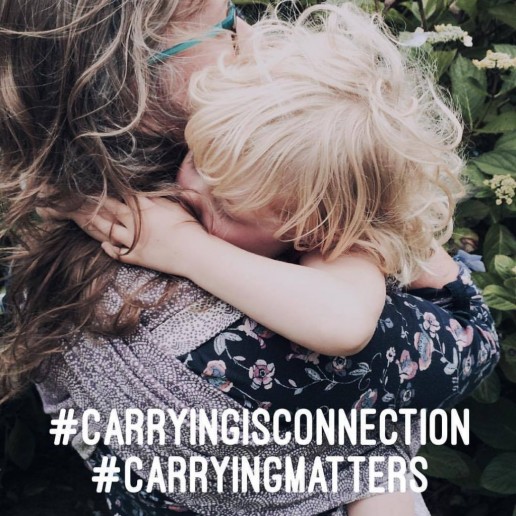
The simple act of connecting with a small person through the medium of loving touch has powerful and long-lasting effects on both child and carer. Babies need to be held close to encourage normal physiological and psychological development, especially in the early months. Every child needs love and connection to grow normally: the absence of responsive and supportive relationships that involve loving physical touch will hamper a child’s potential. Mothers heal best with their babies close to them.
Children thrive when they are carried, resilience builds and families flourish when the needs of all its members are met. Carrying is connection; carrying matters!
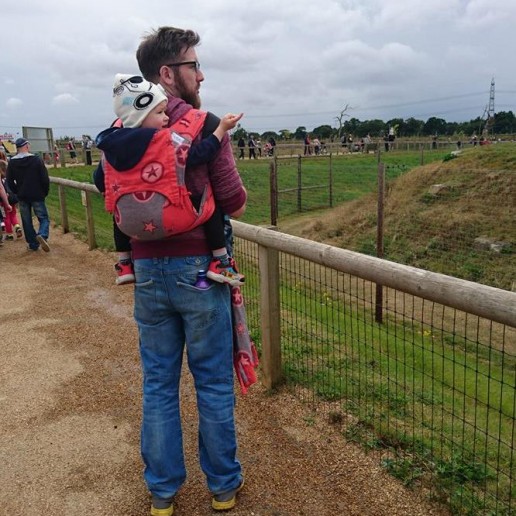
Keeping babies safe in any kind of baby sling or baby carrier is of paramount importance. The first most vital issue is to ensure that baby’s airway is open and unobstructed, with chin off the chest and the ribcage well supported. Babies’ temperatures should be considered too; they are surprisingly warm, and overheating can cause problems. Read more about sling safety here.
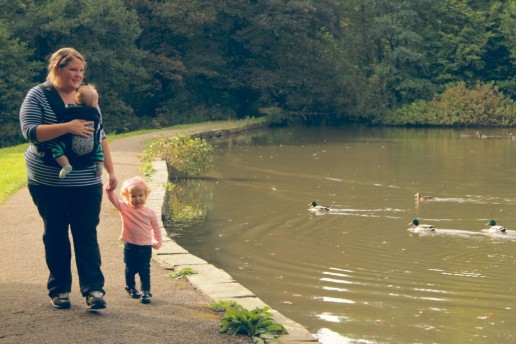
Secure attachment to other people is vital to human health and wellness; we thrive on relationship, on belonging. Such healthy attachments are the bedrock to future positive mental health and enjoyable relationships. However, 40% of children lack secure attachments, and are significantly disadvantaged. Encouraging carers to spend more time in close physical contact with their children is one way to improve children’s resilience and support everyone’s mental health. Soft touch is an essential part of building a happy brain and positive bonds that last a lifetime.
Read more about the importance of building secure attachments here, and how encouraging close physical contact can help build the resilience that children need to thrive despite adversity.
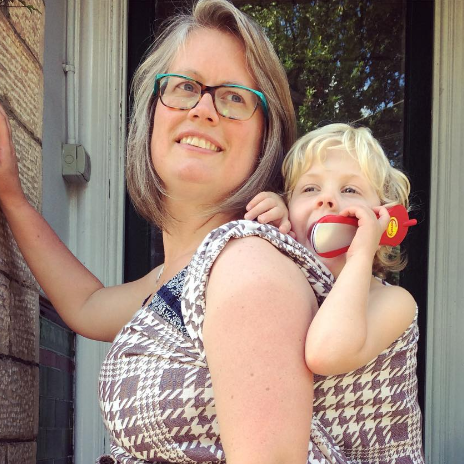
About Rosie
“I am a mum of 2, a family doctor in the UK (a GP), and a passionate advocate of building secure attachment relationships between children and their carers, due to the long lasting effects this has on future health. I believe that carrying children plays a large part in building such bonds, be it in arms or in a sling. With Carrying Matters, I focus on providing accessible information and education about this for parents and the professionals who support them. Sling and carrier use is not a new concept at all; but our Westernised society has lost the communal sharing of knowledge. We are no longer surrounded by a community of people who can help us get to grips with parenthood and share the load, so we need support in newer and more structured ways. This is what I do; empower people to keep their children close in a safe and positive way.”
Her book, “Why Babywearing Matters”, was published by Pinter and Martin in May 2016. It has been translated into several languages over recent years. She has written for a wide range of publications, including Juno Magazine, and has a regular freelance blogging role for Boba (links can be found in the Blog section).
She founded the Sling Pages, an independent website listing all the known sling professional resources in the UK and Eire, and the Building Bonds Project, a CIC supporting families in times of crisis and financial hardship to access good quality and safe carriers.
She is a practising GP in the UK with a particular interest in holistic medicine as well as children and women’s health and medical ethics. She began her career in hospital medicine but switched to general practice because of its flexibility with family life and the opportunities it presents to be more closely involved with communities, from cradle to grave. She has two children of her own, who have both been carried happily, and a husband who works alongside her at their local Sheffield premises. Rosie founded the Sheffield Sling Surgery and Library in 2013 and has supported thousands of parents across the South Yorkshire region, helped by a volunteer team of fantastic, committed parents who have found carrying their own children to be life-changing. They all want to help their fellow parents to discover this for themselves!
Rosie has won several awards for her work in this field; the Babywearing International Vijay Owens Babywearing Advocacy Award for Lifetime Achievement in Promoting Babywearing in 2016 and the 2019 Association for Infant Mental Health AIMH (UK) award in recognition of those who have highlighted and promoted infant mental health in their discipline.
Rosie developed the “Fourth Trimester” sling meet model with her colleague Lindsay Snow, focusing on the needs of parents with bumps to four months. Families often struggle to deal with the biological needs of their new baby within the confined structures and expectations of modern society, which can be damaging to the building of secure attachments.
The needs of baby and caregivers are both important, as is the mental health and happiness of the whole family. Human beings were not designed to live in small isolated units but in supportive social groupings.
Holding babies close (in arms or in a soft sling) can be a very useful tool for families struggling with mental health disorders, pre, peri or postnatally. The close contact and the soft touch has biochemical hormonal effects that can help to reduce anxiety, improve feelings of wellbeing and connection, as well as lifting the mood. Read more about this here.
You can find your local sling library or sling meet by searching the Sling Pages resource, get in touch with them!
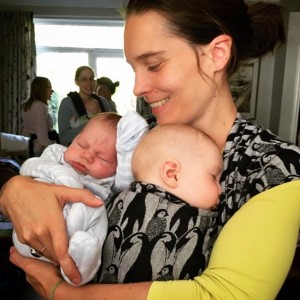
Using a sling (carrier) helps parents to keep their child as close as their biology needs, while also being able to function as adults in a demanding and inflexible world.
Rosie trains carrying advocates and sling/carrier peer supporters and sling consultants, running courses in Sheffield and nearby. She has trained health care professionals, sling librarians, fitness course leaders and interested parents. See more here.
She lectures at conferences and gatherings around the UK and Europe about a range of topics, all related to early years parenting and how slings and carriers can make a huge difference to babies, their carers and to society.
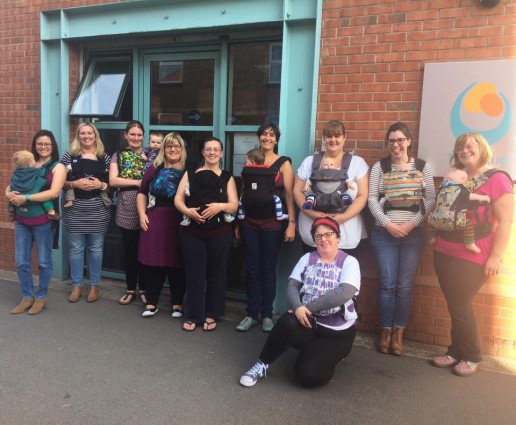
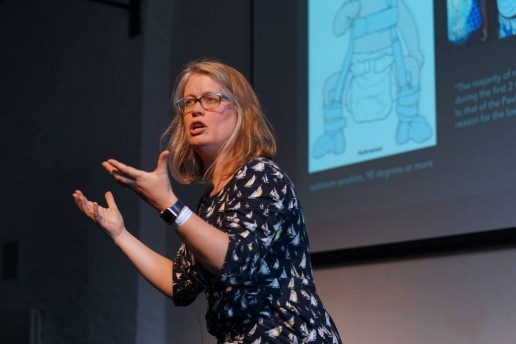
“I’d highly recommend any enthusiast to attend this course. I found it thoroughly enjoyable and look forward to being able to use this new knowledge to help more parents discover the benefits of babywearing, as I have.”
“Rosie is a wonderful teacher, very clear and good at explaining. I felt she was well educated in her field and able to answer any question thrown at her. Also very friendly which made me feel comfortable and relaxed in a learning environment and confident to ask questions.”
The unhelpful "rules" of babywearing
There are so many unhelpful rules of babywearing. I'm not talking about basic safety guidelines, but about the unspoken rules about how things must be done.This needs addressing. I love babywearing. I love how special it is. I love how empowering and enabling it can be and what a difference it can make to children and their carers and the society around them.
I also love that it just makes life work for so many people on a practical level, regardless of all the benefits and reasons about why it is an activity that matters. Babywearing may be magical for many, and has so many positive effects on a physiological and neurological level, but really, for some, it’s just about getting stuff done, keeping the cogwheels of daily life turning, or helping to survive very tough situations.
I have watched thousands of people carrying their children all around the world and I love that I am part of a tradition of child rearing that goes back beyond the history books into our anthropological origins. I love it so much that I wrote a book all about it!
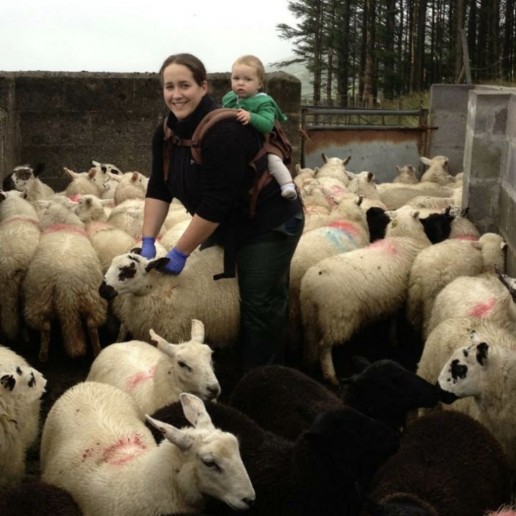
Carrying children is normal human behaviour, and it isn’t, and shouldn’t be, complicated or difficult. It shouldn’t be scary, inaccessible or expensive. It does not belong to groups of people to “own” or to build tall walls around to make things secret or elitist. Babywearing (the use of a sling or carrier to keep a child safe and close to a parent) is for everyone, every gender, every colour, every ability, every size, every shape. Babywearing should bring us together, not divide us. It should not alienate or exclude entire groups of people.
However, as the practice becomes more mainstream and the industry grows, this alienation is unfortunately happening more and more often. Marketing campaigns and the general make-up of many babywearing groups suggests that this is an activity for relatively well-off middle class “standard sized” white women in nuclear families, carrying able-bodied and healthy children. This is a direction that needs to be arrested before it becomes too entrenched. I’ll say it again, babywearing is for everyone and can be done in so many ways.
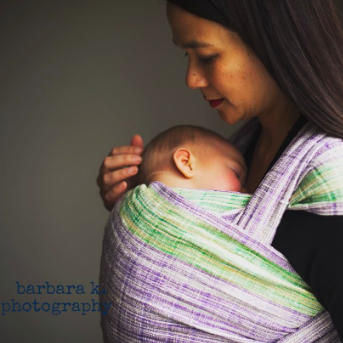
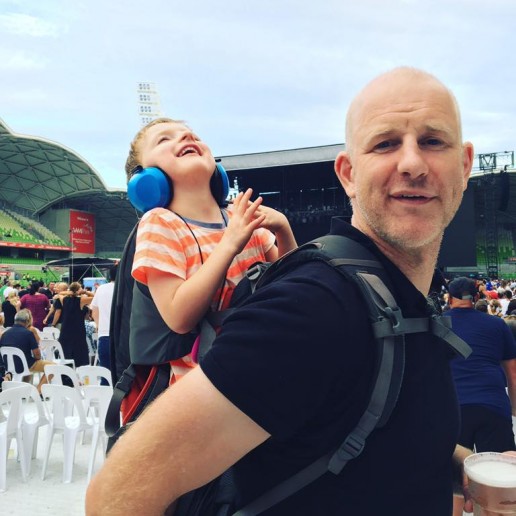
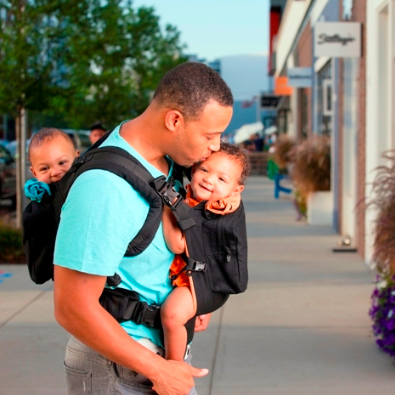
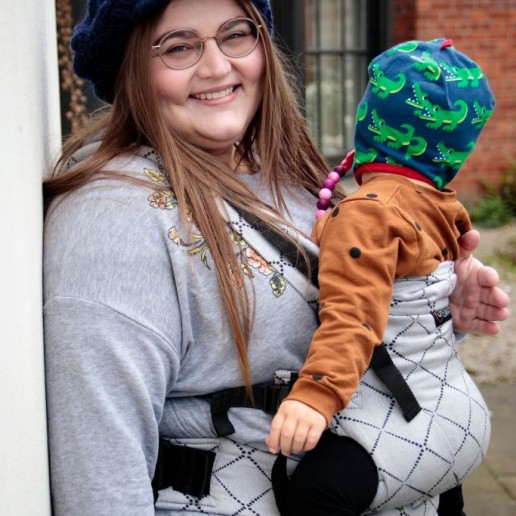
One way that babywearing can become elitist is in the development of complex rules, and I’d like to have a discussion about some of these “rules” and “guides” of babywearing that I am seeing shared around. I understand that it can feel reassuring to have black and white lists of what you can and can’t do, and schedules for certain types of carrying. These can act as a framework for where to begin with using a sling. This is valuable, especially as many of us have lost the shared collective wisdom that comes from living in communities and no longer learn how to parent from the people living around us. Many of us turn to books and to the internet and ask for guidance.
However, I think these “rules” often end up making things harder and disempowering the very people who need the most support. Here are some common examples.
Some commonly stated "Rules"
- Do not use a stretchy wrap beyond three months
- Do not back carry with a stretchy wrap
- Do not use a soft structured carrier for a newborn
- Do not do any form of sideways cradle carry
- Do not use a narrow based carrier
- Do not face your child out in a carrier
- Do not back carry a baby before they can sit unaided
- Do not back carry a newborn in a ring sling
- Low back carries are dangerous, high back carries are much better
- Once your baby is walking you must begin to use a toddler-size carrier
- Bigger children must be carried on the back
- Do not use footed pyjamas for babies in slings
I could go on…
These rules can be useful, but often they exclude significant proportions of the population. You can use a stretchy wrap to carry an older child, if they are safe and comfy. You can use your stretchy wrap in many ways, including on the back, if your child is safe and comfy. You can use a soft structured carrier for a newborn, if it fits them and is safe and comfy. You can carry a child in a sideways seated position or even a cradle carry, and facing out, if they are safe and comfy. You can use a narrow based carrier for a baby or a baby sized carrier for a toddler, if they are safe and comfy. You can carry a baby on your back in any form of carrier if they are safe and comfy. You can carry any age baby on your back or your front if they are safe and comfy. You can carry your child who is wearing footed pyjamas if the child is safe and comfy (ie their toes have room to wiggle). You can carry your child whatever size you are. In fact, you can do pretty much anything you want to do, if your baby is safe and comfy.
Do you get the theme?
Is your baby safe and comfy? Do you feel confident caring for your child with your carrier? Then carry right on!
I think the only “rules” when it comes to carrying a child in any form of sling are
- Can they breathe safely and without any obstruction at all times?
- Are they being held safely and securely in a carrier that fits (to ensure they are able to breathe easily and cannot slump into a position that would obstruct their airway)?
- Are they as comfortable as the circumstances allow?
How do you check if a child is breathing safely in the carrier?
- Look at them, listen to them, be aware of them.
- Check their airways are free of any fabric and they are not slumping or folded over with their ribcage compressed and chin on the chest.
How do you ensure they are safe and snug in the carrier and that it fits?
- A well fitting carrier holds a child close to the parent, close enough that if the parent leans forwards, the child does not swing free. This helps to avoid slumping over in the carrier.
- If a child’s body can slump, the carrier does not fit or is not tight enough.
- The “knee to knee” rule is often overstated in its importance for older children (the M shape can be protective for children at risk of hip dysplasia in the early months.)
How do you ensure they are comfortable in the carrier?
- This is all about being responsive and connected to the child being carried.
- They should fit inside the carrier, be able to breathe safely, and should not be too hot (overheated babies are more likely to stop breathing).
- Check on your child, be aware of their experience and how they are behaving in the carrier. The more you interact with your child the more you will know that they are OK (or not!)
If your baby is safe, able to breathe and is comfortable, and you feel confident that all is well, then it probably is well. Carry right on! And if you would like some encouragement, find a friendly educator and help them learn how to support you in a way that builds you up and keeps you carrying happily.
Real life is lived in the grey areas, in between the black and white.
It is important to remember that every child and every parent has different needs. Parents of twins may need to be able to back carry one twin from a very early age, to be able to cope with family life. They may choose to use a buckle carrier on the back, and if the child is able to breathe safely and is not uncomfortable then that makes their lives work. Telling them this is forbidden creates needless barriers and makes life harder. A stretchy wrap for a one year old may not be as comfortable as a woven wrap, but for a parent on a budget who now has a less-unhappy toddler held close while the baby can be cleaned, this is a win-win situation. A four month old who will will only tolerate facing out in a narrow based carrier can be happily transported on a school run. Millions of women around the world have carried young babies in low torso carries with simple pieces of cloth. A disabled child who cannot sit unaided can be held safely and securely on the back in several types of carrier which will definitely make everything much easier. Do be aware of how your language and how you educate can affect others and significantly disempower people.
“Oh, but these rules are for normal people!” This is a common dismissal of any criticism of “rules” and is unbelievably inappropriate. Our society is made up of people of all abilities and all skills. More than one billion people in today’s world have a disability; that’s 15% of the population. This ratio may not be reflected in the proportion of children who are brought to babywearing groups, just like people of colour are missing from these gatherings. The fault is not theirs; it is ours. We must be more inclusive and we must make efforts to reach out to people. Just imagine how different things could be, if some of these walls of prejudice were pulled down from the inside.
Grainne and Tessa are a great example of how babywearing can actually empower beyond the “rules.” Little Tessa was born without a nose (arhinia) and had to have a tracheostomy when she was very young. Her family were told that she was safest to be sleeping in a separate room with various wires and monitors attached to her for any alerts in a change of breathing. In fact, Grainne decided to wear Tessa in a sling, keeping her close and safe and visible at all times; if Tessa stopped breathing, Grainne would see it and feel it as it happened, thanks to the sling (read more about them here.) The sling made life work for them, and also made it much happier during some very tough times. Common sense, knowledge of safety and a willingness to bend the rules worked together to enhance their lives, when they could so easily have missed out.
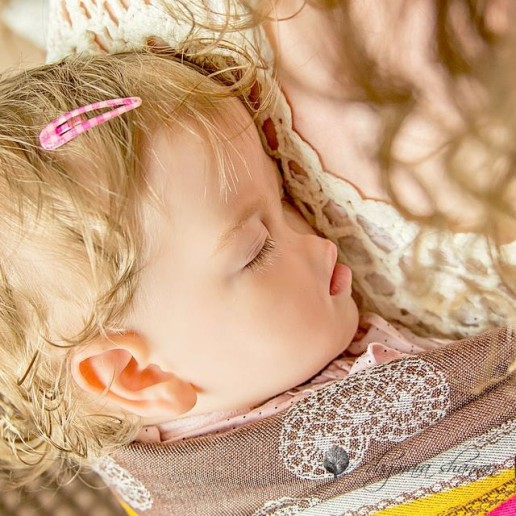
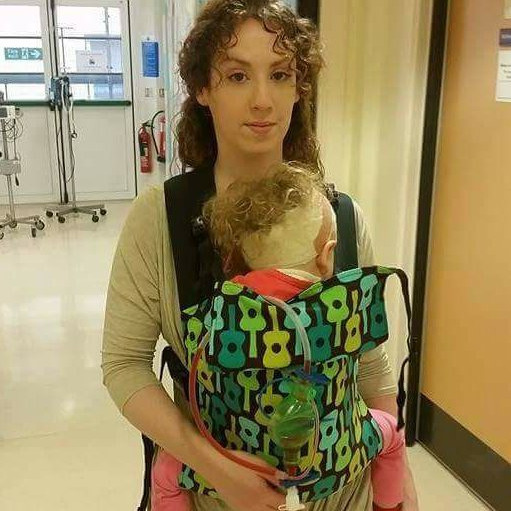
This is a superb blog for further reading; all about ableism in the babywearing community and I urge you to read it.
http://bindungtraegt.de/ableismback-wearing/
Please also read the Tania Talks blog posts on babywearing (she is a wheelchair user)
https://www.whentaniatalks.com/the-realities-of-back-carrying-as-a-wheelchair-user/
https://www.whentaniatalks.com/back-carrying-as-a-wheelchair-user/
Beginning to Back Carry
When is it safe to begin back carrying with a sling? This is one of the most frequent questions I am asked and I usually answer with more questions, as there is no one single answer!
Children have been carried on their parent’s backs since the dawn of the human race, because it is a simple and convenient way to carry a child around as you get on with daily life. Families in different cultures from our own tend to share parenting skills and knowledge within the community, so there needs to be no formal teaching, it is just what has always been done and everyone learns how to do it from observation and previous experience (siblings often carry new babies). Babies in traditional families are back carried in pieces of cloth from a very young age without any fuss. It is normal behaviour, and allows meals to be prepared and water to be collected while baby sleeps peacefully in a safe place.
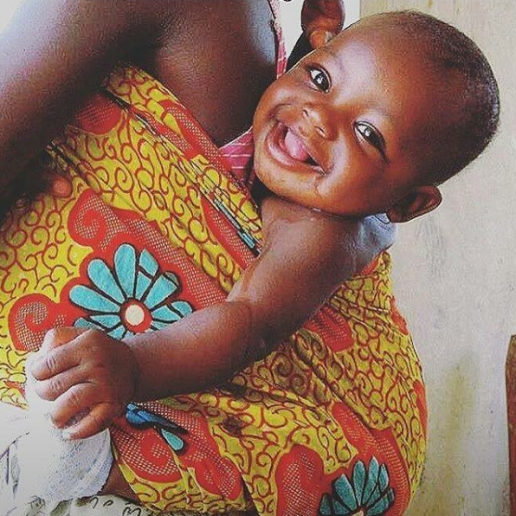
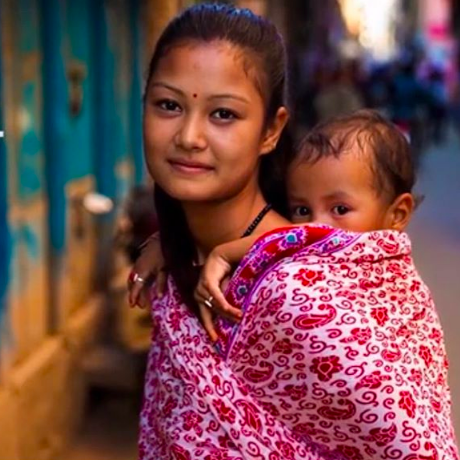
This is a very different way of doing things than in our Western culture, where we have lost much of the communal family life we once had, and parenting skills are no longer passed on in the same way. These days, we need to learn about how to care for our newborns from other sources than our local neighbours; we create virtual villages with social media, rely on organised groups of mums and look on the internet for information about feeding and sleeping. Carrying methods are just the same; infants are not routinely carried in slings and thus we need to ask for advice. This is where sling libraries and consultants are so useful; they are parents who have discovered carrying skills for themselves, honed and practised these skills, and wish to share their expertise with other parents so that carrying can be promoted – carrying children matters.
Front carrying is the most common position for young babies; central or slightly off centre, as this mimics natural in-arms carrying that babies enjoy so much. The closeness and sight of your newborn promotes oxytocin release (vital in attachment) and adds a measure of confidence for you, being able to see any changes in breathing patterns and allow quick and easy rearrangements if needed).
Back carrying can be a particularly contentious issue in Western culture; nobody seems sure what the “rules” are and lots of different advice can be given out.
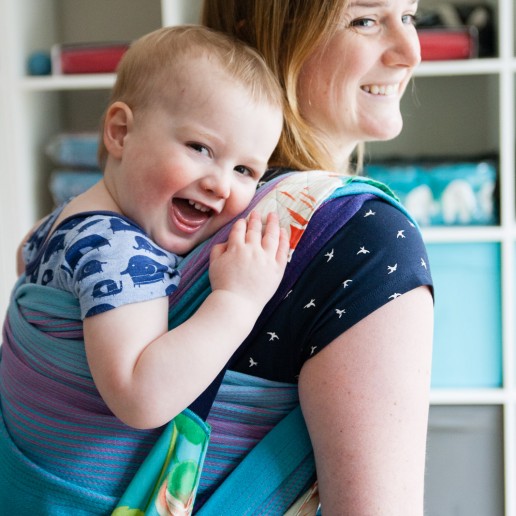
Back carrying can be done from almost any age, with appropriate care and caution for protection of airway and spine, and with the appropriate sling to facilitate this safe positioning (see the position image). Quite often, parents who have learned how to back carry older children will feel more ready to begin this with their new babies at an early stage, if they want. However, you can learn to carry your first baby on your back and there will be support from professionals if you need it – it can make a big difference, having a guiding hand as it can be scary! The more confident you are with handling your baby and your carrier, the easier it will be.
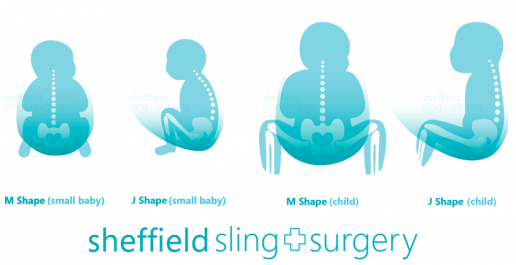
Not every type of sling is suitable for back carrying. For example, while some buckle carriers do carry newborns very safely on the front, they are usually snug and high up on the chest (close enough to kiss) and any changes in airway position can be quickly seen and corrected. It is much harder to monitor your newborn baby in the same buckle carrier on your back (which will usually end up quite low) and to be sure that your baby is properly supported inside the panel without any slumping over or chin sinking onto the chest. (This is due to their immaturity and greater muscle fatiguability even when they have some head control). Most buckle carrier manufacturers will state their minimum age for using on the back and it is wise to respect this.
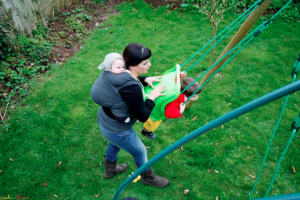
Some stretchy wraps can be used for back carries (see here for more) if they are designed to do so and have been appropriately tested. It is a common myth that you should never use a stretchy for a back carry, however they can be very hard to do well. It requires skill and this is best learned from someone who knows how to do it, for safety. Some people will choose to use a different carrier that they find easier or more convenient.
Let’s look at some common questions around back carrying.
Can I carry my newborn baby on my back?
Yes, newborns can indeed be carried safely and comfortably. They will need frequent feeding and changing, but many will settle happily to sleep in a back carry. The safest way to do this is usually with a soft and floppy woven wrap. This is because woven wraps are a collection of individual strands and can be carefully tightened section by section to ensure your baby is fully supported from neck to kneepit, with the airway open, spine kept in the physiologically appropriate gentle curve and knees just gently apart to preserve healthy hip positioning. Such back carries are usually done high up on the parent’s back, so they are able to see their baby’s face and feel their breathing on the back of their neck. Most people will choose to do the simple rucksack carry, as the ruck pass doesn’t overspread the hips, and the single layer doesn’t drag fabric at an angle against the back. (Some babywearing schools will insist that this is the best carry to use for the first six months; other schools of thought are more flexible, but on the whole, ruck carries do work best for very young babies). Getting baby up onto the back can be a challenge; the Slingababy video below shows one way to do so safely.
Some very mouldable mei tais (usually made of wrap fabric for the mouldability and control) can be used for back carrying young babies too.
Older babies can be carried in wraps lower down, as in the African pictures above, as the fabric moulds around them properly. It is a common myth that all babies are best off in a high wrap back carry, or that they are safer; it is all in the positioning and skill to keep their airways open. Many parents find lower back carries can be more comfortable than higher ones, especially if they have back pain. It is worth trying a few carries out to see which works best for you and your baby. Videos from trusted sources can be useful, however, not every video on YouTube is a good one; some neglect basic safety checks, and not everyone finds videos an useful way to learn things. Your local sling professional should be able to support you!
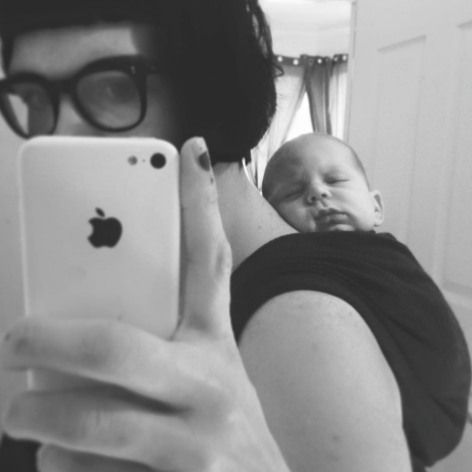
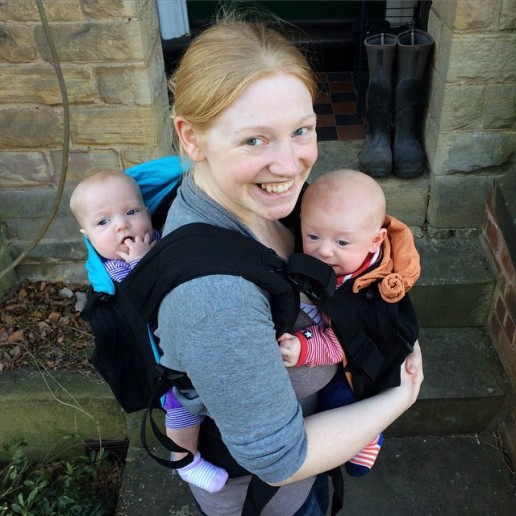
When can I put my baby on my back in a soft structured carrier? (eg meh dai, full buckle carrier)
There are no real “rules”. “Rules” are often misunderstood/misinterpreted and can cause needless delay. It is worth noting that most structured carrier manufacturers will have guidelines regarding their use for different positions, and it would be wise to read these to ensure you are within warranty. Every parent needs to make their own decisions regarding when it becomes appropriate to back carry, weighing up their need/desire to back carry with considerations for safety and security. All carriers must provide enough support to prevent slumping and airway compromise.
On the whole, most people feel that the best time to begin back carrying in structured panelled carriers (that may not mould in the same way as a wrap or floppy mei tai and are unable to provide neck support to heavy heads, and generally sit quite low down on the body rather than keeping babies high up near the parent’s neck) is when baby’s upper body and torso muscles are strong enough. They need to have enough endurance to be consistently able to support themselves and hold their heads upright for a significant amount of time without tiring. This typically occurs when babies are beginning to sit unaided (or nearly). This commonly happens around six months, on average – it varies from child to child.
Some children may take longer to develop upper body control, but their parents may be struggling to carry them on the front; do go and see your local sling specialist who can help you find some solutions to this problem and keep you carrying. Generally, if the carrier fits your child properly and provides the necessary support, you can back carry in it. (This will apply to children with disabilities for example; it can take longer to gain head control but back carrying may be important. The right carrier that fits well and is used optimally may work just fine; do go and get some help!) Read more about back carrying children with special needs here in a fantastic article about ableism in the babywearing community.
Some parents will feel the need to back carry a little earlier, for example, parents of twins. The TwinGo carrier suggests that their carrier is suitable for babies of 4months plus, with “strong and consistent” head control. Of course, this control comes to some babies sooner than others, and factors such as the size of your baby and the width of the carrier may play a part in decision making, as well as the presence of other adults for support should your baby need some help.
It is possible to monitor your young baby’s safety on your back with useful items such as mirrors, plus you can often add head and neck support using the hoods. Don’t be afraid to ask a professional for help!
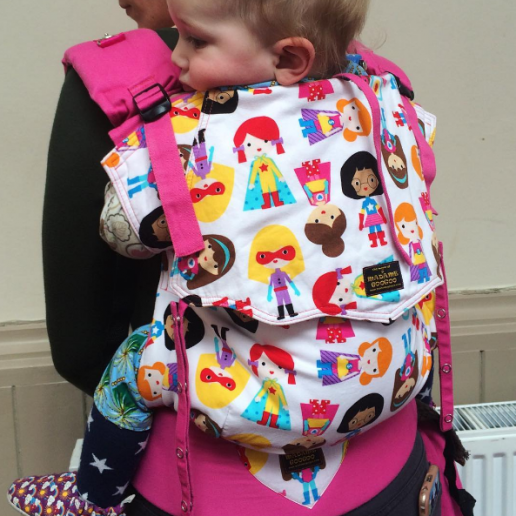
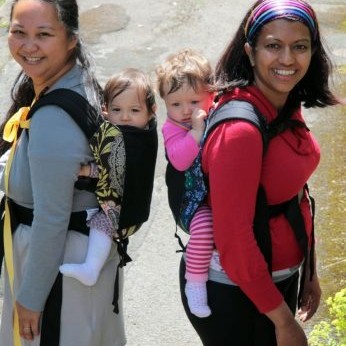

How can I get my baby on my back?
This usually depends on the carrier you are using, and your levels of confidence, and the community you are part of. If you have grown up watching your family carry babies, it will feel like second nature – but if not, this is where getting advice and support can be so very useful.
Back carries with buckles and meh dais are relatively straightforwards and there are many ways to do it. Some manufacturers will have very simple instructions (which may not always be the most easy to follow), and there are videos on YouTube. It is always best to look at videos with a critical eye to see how well it is done, and those made by trained professionals who are used to making videos are usually the most reliable. My back carry with buckle videos may be useful here – at no point is baby or carrier unsecured.
Here is a link to my photo tutorial for the “one up one down” method.
The key thing is to know your carrier and know your child. Being familiar with the buckle placement or or how to tie knots/tighten webbing is important. If you have a willing child who will comply with back carrying, it will be easier to practice, however, if your child is very unwilling, it may be best to wait for another day. You may be able to distract your child with a small toy as you go, and mirrors are useful so they can still see your face if they are not used to seeing the back of your head and wonder where you have gone!
Your local sling resources will be happy to teach you and this may be a very good way of rapidly improving your technique and confidence.
Back carries with a ring sling can be very useful, especially as the “seat” of the carry is created on the front or side of the parent, and then shifted around to the back. There is a knack to this, and also several ways to make the carry more secure and comfortable.
Back carries with woven wraps can be more tricky, as the fabric needs to be tightened around the child bit by bit, and again, a willing child is a blessing for those learning how to do it. The age at which you start will influence your choice of method; most experts will suggest a bundled “santa toss” with the baby already secured in the pouch for newborns, as this is the most controlled and safe way. Of course this will depend on your previous experience. Older children (3months plus with hips opened enough to sit on the hip), can also be put on the back using the hip scoot. Over the shoulder “superman” tosses are popular, it is wise to ensure you are fully supporting your baby by their shoulders, rather than holding them only by their arms (which can put some pull strain on shoulder joints). It takes practice to do it well – even seasoned babywearers who feel confident can find back carrying with a woven wrap a challenge, and none of us get it right every time – the “wrapping mojo” is real!
I really do recommend seeing a professional to get some help and teaching if you are planning to back wrap a young baby, as there is a lot to get right. For example, the correct tension to support neck and airway for safe breathing, getting it snug all round to avoid baby slumping to one side or slipping down inside, and getting the right amounts of slack out at various points to ensure there isn’t too much tightness around the neck and the knees which can leave red marks. Some people do teach themselves to back carry with videos and manuals and with their peers, but there is no harm and much to be gained from trained support (just the same as getting support with breastfeeding, or learning to drive a car – an instructor will probably help you to be ready for your driving test sooner than a non-professional.) I have some videos here which I feel may be best as reminders.
Back carries can be useful for pregnant mums, once the bump gets a bit too big for front carries, or if pelvic pain strikes, making hip carries hard (these are best limited if possible anyway, to avoid uneven loading of loosening ligaments). It is wise to build up your strength and tolerance for carrying as your body changes; little and often is key.
In summary, back carrying can be great fun. It is challenging to do well, and takes practice, however, once mastered and done safely, it can be very satisfying, and for many, it adds a new lease of life to their carrying journey. I do urge you to seek the services of teachers to help if you are finding it hard, or uncomfortable – we are here to support you and empower you to keep on carrying!
And don’t forget; sometimes front carries are just as lovely!
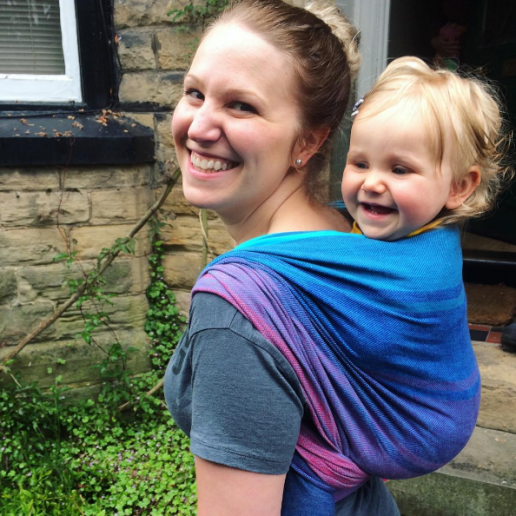
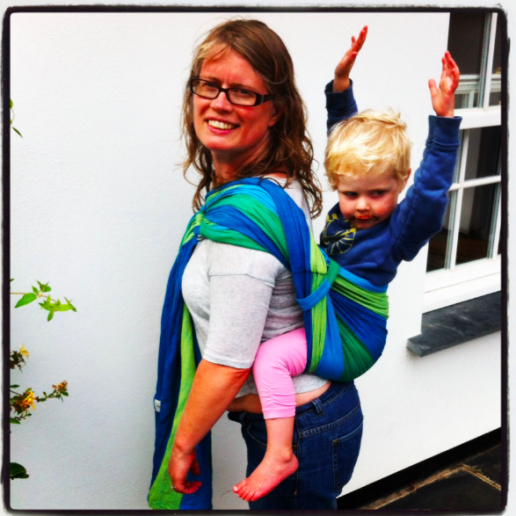
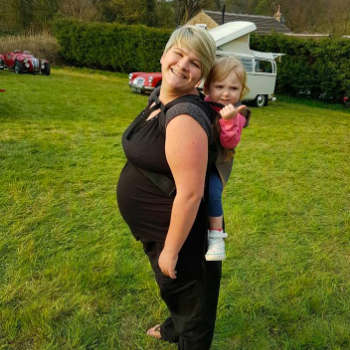
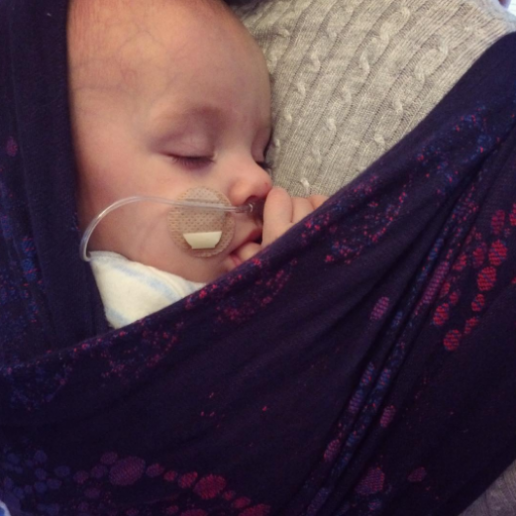
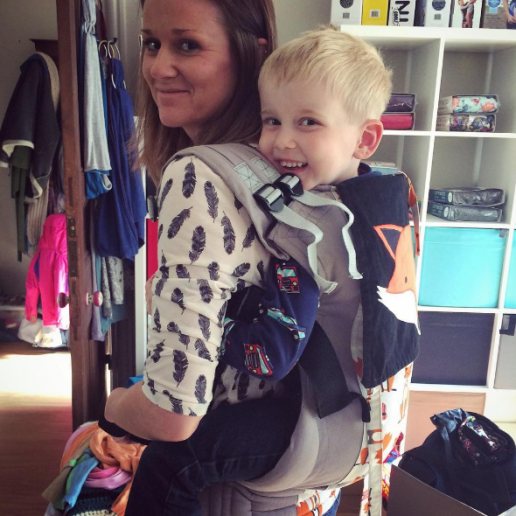
Beyond the "Knee to Knee"
How much does it really matter to have a carrier that fits from one kneepit to the other? Read on for a discussion of this topic that moves beyond the knee to knee.
Quite a few people visit my sling library on the lookout for toddler carriers, as their little ones are “no longer knee to knee” in the sling that they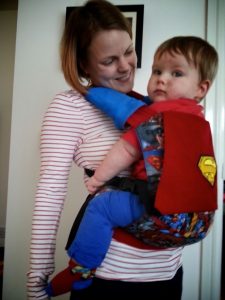
In Sheffield the problem arises particularly in relation to Sleepy Nico baby carriers, which are very well loved here. People are reluctant to move into other carriers that may not feel so comfy,, but don’t wish to hurt their children or be unsafe by using a sling that may be too small, or moving to a “toddler size” that may actually be too big!. There is a lot of conflicting information on the internet about the sizing of carriers which many people find very confusing to navigate….
SO…
1) What is knee to knee?
Knee to knee simply means that the carrier you are using supports your child across the full width of both thighs, from one knee to the other, reaching into the knee pit. This ensures a comfortable seat for your child, more like sitting in a hammock, than perching on a stool. The diagram below shows a carrier that is reaching knee to knee, and the side on view shows how this will create a comfortable seat.
Having the knees raised above bottom also increases flexibility at the hip joint and makes it easier to flex and extend. Try it yourself! Sit astride a chair, facing the back. See how easy it is to shuffle forwards, keeping your legs flat on the chair seat, to get your symphysis pubis (the front pelvic bone) to touch the back of the chair. Those of us with lovely flexible hips who can do the Buddha position easily will find this a doddle, but others of us will find it a little sore as the ligaments get strained. You can release this tension instantly by bringing your knees up above the level of your bottom, and this will often tuck your pelvis inwards, bringing a little curve to the base of your spine. This position you have created is called the M shape, for obvious reasons, and is the ideal position, supported knee to knee with bottom a little lower. There are a few circumstances where this standard recommendation may not be appropriate, and more care will need to be taken, such as children with hyperextension conditions, or achondroplasia for a start. If you are at all unsure, do see your local sling and carrier consultant or ask for advice from trained professionals. We are always happy to help with tailored advice! For more information if a narrow based carrier will harm your child’s hips, see my “Healthy Hips” article.
2) What if my carrier seems to be no longer knee to knee?
There are usually several factors to consider here, depending on the age of your child.
Firstly, is your young child sitting in the M shape, with their bottom sitting deeply in the panel, and knees raised up with pelvis tilted? This often makes a big difference to how young children sit in carriers, and you may find it instantly makes things more comfortable for you and your child, especially if the panel has also previously felt too short. It is worth taking your time over positioning your child really well and may extend the life of your carrier for some time.
Older children who can stand and walk do not need the same level of support and will be fine if the carrier offers them good thigh support. It should keep them in a comfy seated position with lower legs bent at the knee, at right angles is fine. Older children have more muscle strength and co-ordination, and can help to grip on, so they do not need full knee to knee. They need more space and freedom to move, and will want to get down more often anyway! In this photo the sling is not reaching to the kneepit but to mid-thigh. Just make sure there is no digging in of the fabric along the thigh, and no pinning of knees with wrap fabric passes.
Secondly, is your child central in the carrier? I find that people have a tendency to hold their children slightly off centre when in arms, and then bring the panel up from that place so the child remains in a similar off-centre position. This will mean that one leg is less well supported than the other, and can lead to leaning and discomfort. Keeping a child central will often improve comfort both for your child, and for you.
Thirdly, is your child comfortable or not? Older children may be able to tell you, but for younger ones, our role as parent is to be caring and careful, and aware of non-verbal communication. Sling users usually worry (in the early stages with small babies) about over-spreading hips, as babies cry when they are uncomfortable, and children vary in their hip flexibility. This is why many carriers are “cinched” in when they are too big. Always listen to your child. If they are comfortable, and happily able to move their legs at the knee, and legs do not seem to be dragging down but are well supported, you may not need to size up just yet.
Fourthly, is your child growing taller as well? This may be more of a problem than the width of a sling if a child has a very long body and is able lean back too far from a panel that is too short. If your child leans back too far they may unbalance you. Keeping yourself and your child safe is more important than being knee to knee.
If your child is happy in their current carrier, that is good news. If they are not, and legs seem to be dangling unsupported in more of an A shape, or they are able to lean back, it may be time to consider another, bigger carrier. It might help to look in the mirror to assess your child’s leg position and how much back support they have.
3) Is it unsafe to use a carrier that is too small?
It depends on the child, and the parent! As I have pointed out in my Healthy Hips article, there is little evidence that a “narrow” seat will be harmful to any child beyond the age of six months, and even before then, the risk is low. So an older child, especially when they can bear their own weight on their legs, is not at risk of damage from not being perfectly knee to knee. They may not be as comfy as they could be if the carrier is very small and they end up with legs dangling in an A shape (this could be tiring for a child, and lead to red marks on the inside of the thighs). Let your child be your guide. I usually suggest that a carrier that supports at least to mid-thigh and allows a comfy seat with knees at right angles or a little less for older children, is fine to use.
Many big brand carriers such as Beco, Boba, Ergo and Manduca to name just a few, say that their carriers are safe to use well into toddlerhood, long after some people would feel their babies were too big for them (they are all formally safety tested). Sometimes it can seem that people are in a hurry to move out of a “standard” size carrier, before it is really necessary. Again, check your positioning, and do get some help from your local sling consultant/peer supporter/library/sling meet if you are unsure. One size does not fit all, some babies are big, some toddlers are small, some parents find bigger carriers more comfy for them, some parents find smaller carriers work better for their frames. Each carrier has its own specifications too. Some are narrow, some are short-panelled, some are wide, some are tall, some have buckles that insert very low and can squash baby thighs, etc. It is all dependent on the individual situation, and what works for one baby and parent may not work for another. Skill levels vary too, as does child compliance – a contented baby may be happy for the parent to take the time to maximise positioning, others may resist.
If you have a half buckle, or a meh dai, there are ways to tie the shoulder straps to come beneath the child’s knee, to further extend the width of the support offered by the panel itself.
4) Is it unsafe to use a carrier that is too large?
This is a more complex issue. The crucial issue to consider is child safety, based on the ABC and the TICKS guidelines. A child should not be invisible inside a carrier that is too tall, as this could be a risk to their airway and their breathing. This is one reason why many carriers have inserts, to raise children higher up the panel so their faces are visible at all times and chin can be kept off chest. I would rather see a child that was in a carrier slightly too short in the body, than in one that has too tall a panel.
As for the width and knee to knee…
A carrier that is too wide will make a child’s legs stick out straight, or he will strain against the fabric to bend his knee (which may lead to red marks, even if no voiced complaint at the time). He may feel some strain at his inner thigh if he cannot bend his knee in this hip-extended position (see the chair illustration above). Sometimes it can be suggested that the panel could be “cinched in” with something like a webbing belt, or a ribbon, etc and this may, if there is no alternative, make the carrier much more comfy as he is now able to bend his knee in the M shape. However, this will invalidate the warranty of the carrier and place strain at the waistband.
Also, by bringing the knees up higher, the angle that the hips need to open at the groin is reduced, as the joint is able to rotate more easily. *Please note that this is a hack that is rarely recommended ; if it is not in the instructions it will invalidate any warranty.*
Summary
Every parent, child and carrier combination is individual, and needs assessing as such. Many carriers that are not knee to knee may well be able to be used for your child for longer than you might expect, so there may not need to be a great rush to size up. Buying new carriers for many is great fun – if you are going to buy something too big for your child to grow into, do ensure it is comfortable for them, and not too tall. You may have more time in your current carrier than you think, to give you time to find the next carrier (if needed).
But what about the Superman Sleepy Nico at the start? Is it OK? I think we can all agree that the little SuperBaby will be OK to enjoy his special carrier for a while longer yet.
The Pelvic Tuck
What is the pelvic tuck or scoop?
I am often asked by carers who want to carry their children safely and comfortably “what is a pelvic tuck and how do I do it?”
Babies are born with gently curved spines, and usually prefer to rest in this tucked posture when they are relaxed. Arching the spine and “starfishing” can (for some) be an attempt to communicate discomfort or distress. Sleeping and relaxed babies can usually be found with their knees drawn up into a comfortable “M shape”; this is normal behaviour, and it is how most babies rest on their parents, perching on the broad secure base of the carer’s forearm. From this broad base, babies’ chests can be properly supported against the parent’s body, thereby avoiding slumping over and restricting airways.
This “squat” positioning also helps to encourage healthy hip development. Studies have shown that the rates of hip dysplasia are lower in communities that carry children on the hip or back frequently, as the posture adopted for this promotes optimum growth of the hip joint. (see here for more information on hip dysplasia and slings).
The pelvic tuck/scoop technique of encouraging a child to sit in a position that creates a “J shape” (from the side) or an “M shape” (from the front) in a carrier is therefore very helpful. Such positioning is more comfortable, more respectful of anatomy, and also helps preserve open airways. The aim is to raise the knees up, allowing the bottom to settle downwards into the classic “M shape”.
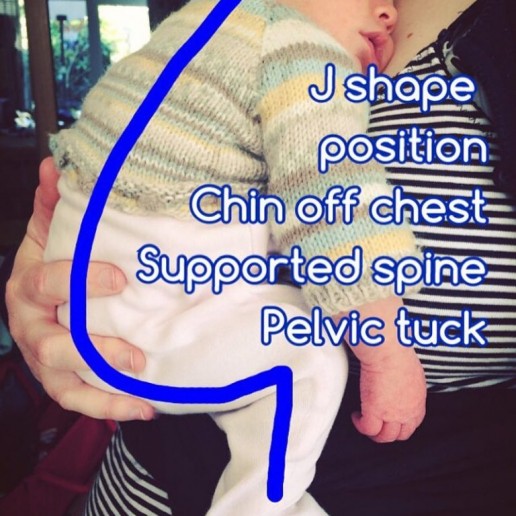
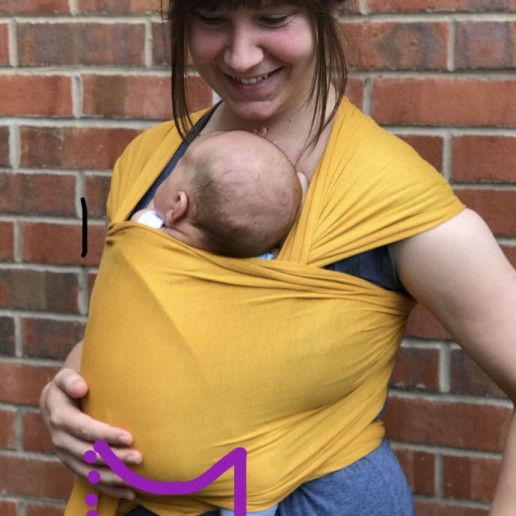
When demonstrating, I suggest that carers imagine they are scooping two curls of ice-cream towards themselves with both hands; and then repeat this action as they hold their child’s thighs gently between thumb and fingers. Another way of thinking about it is to imagine they are holding two glasses of water in front of themselves, and then pour the water out away from them.
This rotates baby’s femoral head in the socket. The photos and videos below show this in action.
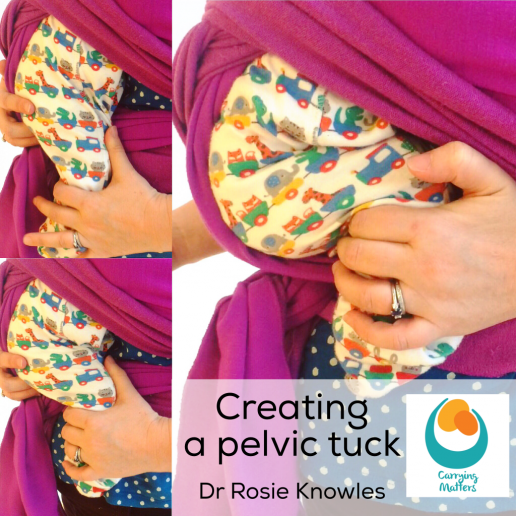
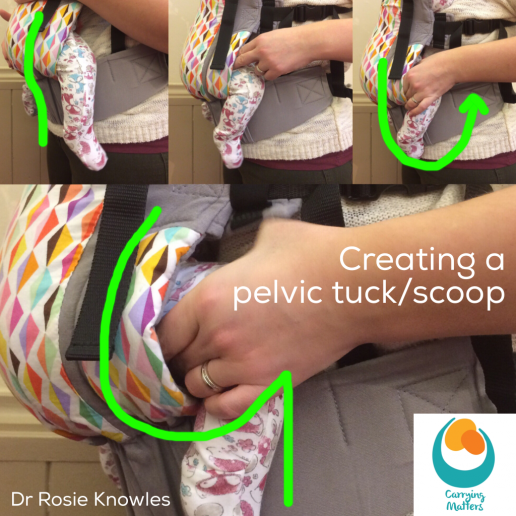
Creating this broader base seat for a younger child will also help to make a narrow base carrier more comfy and feel more stable and supportive. A simple scarf can be used to support the legs in this “M shape” once the pelvis has been tilted and knees raised above bottom.
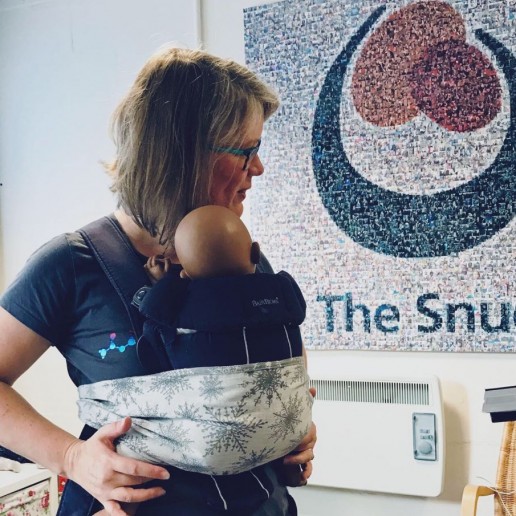
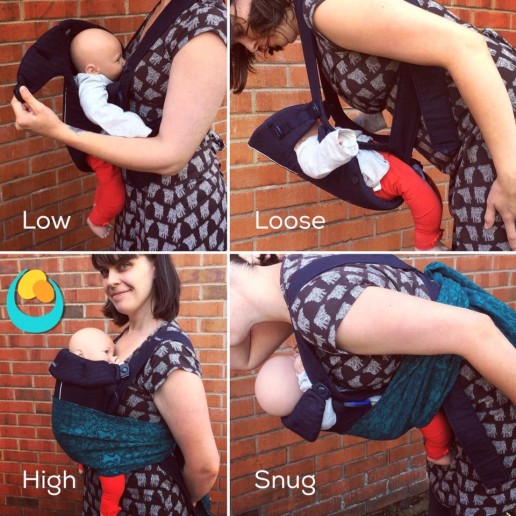
The pelvic tuck is less important for older babies and toddlers; as children get older, the ability to actively move around in the sling becomes more important while they are awake. The key thing is to ensure they are comfortable and their legs are not dragging down or tiring them; the carrier no longer needs to be knee to knee for older children.


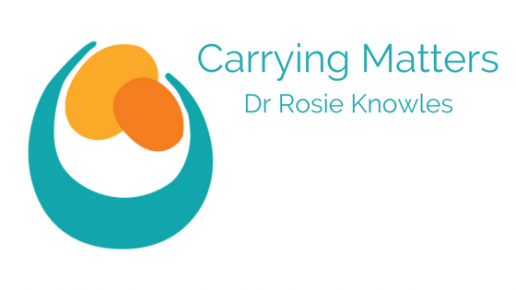

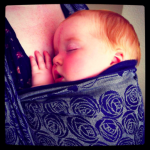

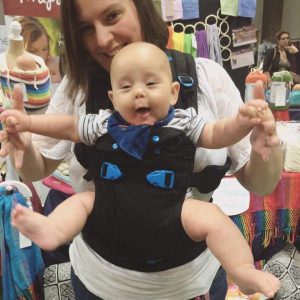
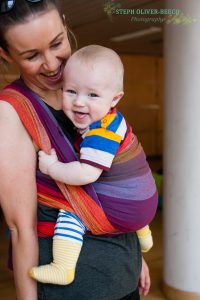
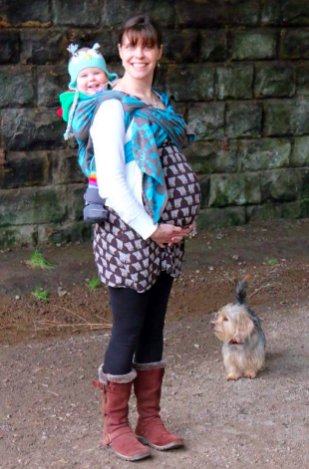
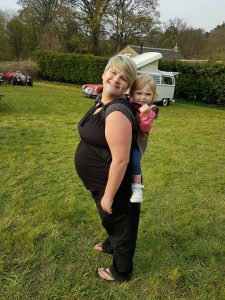
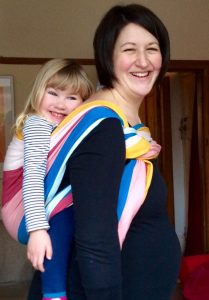
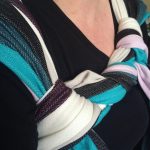
 Third Trimester
Third Trimester